UK Edition Change
- UK Politics
- News Videos
- Paris 2024 Olympics
- Rugby Union
- Sport Videos
- John Rentoul
- Mary Dejevsky
- Andrew Grice
- Sean O’Grady
- Photography
- Theatre & Dance
- Culture Videos
- Fitness & Wellbeing
- Food & Drink
- Health & Families
- Royal Family
- Electric Vehicles
- Car Insurance Deals
- Lifestyle Videos
- UK Hotel Reviews
- News & Advice
- Simon Calder
- Australia & New Zealand
- South America
- C. America & Caribbean
- Middle East
- Politics Explained
- News Analysis
- Today’s Edition
- Home & Garden
- Broadband deals
- Fashion & Beauty
- Travel & Outdoors
- Sports & Fitness
- Sustainable Living
- Climate Videos
- Solar Panels
- Behind The Headlines
- On The Ground
- Decomplicated
- You Ask The Questions
- Binge Watch
- Travel Smart
- Watch on your TV
- Crosswords & Puzzles
- Most Commented
- Newsletters
- Ask Me Anything
- Virtual Events
- Betting Sites
- Online Casinos
- Wine Offers

Thank you for registering
Please refresh the page or navigate to another page on the site to be automatically logged in Please refresh your browser to be logged in
How 9/11 changed travel forever
The attacks may have sparked a new era of tightened security for tourists and left new york city swept clean of its beloved visitors - but the city’s resilience is as strong as ever, writes sunshine flint, article bookmarked.
Find your bookmarks in your Independent Premium section, under my profile

Sign up to Simon Calder’s free travel email for expert advice and money-saving discounts
Get simon calder’s travel email, thanks for signing up to the simon calder’s travel email.
G one were the Gothic arches at the base of the towers that echoed the ones in stone on the Brooklyn Bridge; gone was the steel tracery that drew a bow across the bridge’s soaring strings from the tip of Manhattan – a favourite tableau for snap-happy tourists, until that day. Gone were the red carpets in the lobbies where visitors took express lifts to the Top of the World observatory on the 107th floor of the south tower, or to a glamorous lunch at Windows on the World in the north tower, a restaurant so lofty that diners gazed at the curve of the earth from their table. The mourning was for the lives lost, of course, not for a tourist destination. But the destruction of these icons created a massive shock that was felt around the world.
In the immediate aftermath, that shock generated a massive change across all aspects of travel, most obviously seen in aviation and airport security. August 2001 had seen a record high of 65.4 million airline passengers. It took nearly three years for air travel to rebound, with that number being surpassed only in July 2004. Those passengers faced a very different experience from what the flying public had known before. Immediately, security lines at the airport became hours long, while the creation of the Transportation Security Administration in the US codified a way of flying that is now the norm.
Travellers today doff their shoes and jackets at security, pack no more than 100ml of liquid in their carry-ons, endure invasive pat-downs and enhanced body-scanners, all as a matter of course. Surveillance and tight visa restrictions are de rigueur, and international passengers flying into JFK and other US airports have their fingerprints placed on file and are subjected to more questioning by customs and immigration agents. Air travel was transformed, practically overnight, into something frustration-filled and complicated.
Meanwhile, in New York, nearly every institution, sporting event and cultural site had to rethink its security operations, from installing metal detectors and using bomb-sniffing dogs to banning water bottles. Some, like the Statue of Liberty, closed for years, while others, like the Metropolitan Museum of Art, reopened almost immediately, directed by the city to be open as a place of solace to New Yorkers.
- 9/11 memorial news – live: Bush says US faces extremism threat ‘from within’, as victims’ families pay tribute
- I escaped from the 80th floor of the North Tower on 9/11 – then it collapsed on me
- ‘I’m so thankful for that message’: The final calls made by 9/11 victims that still comfort grieving relatives
“We reopened on the Thursday morning,” says John Barelli, chief security officer at the museum from 1986 to 2015 and author of Stealing the Show: A History of Art and Crime in Six Thefts. “We always had enough staff covering our entrances and galleries, we just retrained them. We instituted bag checks and electronic wanding at the entrances, for metal and weapons, at the three public entrances, and inspected every vehicle coming into the public garage. We did a lot more with the CCTV.” Like other major institutions, the museum also started receiving regular briefings from the FBI and NYPD’s Joint Terrorism Task Force.
Air travel was transformed, practically overnight, into something frustration-fuelled and complicated
Hotels had to make similar security assessments. “Hotels had drills with the task force and the FBI, and ramped up security in their lobbies, with some of the larger ones installing metal detectors,” recalls Vijay Dandapani, president and CEO of the Hotel Association of New York City. The detectors were scrapped quickly as hotels realised they sent the wrong message to guests about the safety of the city.
But as New York recovered, with its new security measures in place, fewer international tourists were there to see it. In 2000, there were more than 35 million visitors to New York City and, of those, 6.8 million were international tourists. In 2002 that number declined to 5.1 million and didn’t reach pre-2001 levels again until 2006.
International visitors are incredibly important to New York’s tourism industry, with the four top countries of origin being China, the UK, Brazil and France. Crucially, they spend more than domestic tourists. “While international travellers account for 20 per cent of visitors, they account for 50 per cent of spending,” says Christopher Heywood, EVP of global communications for NYC & Company. “They stay longer and they spend more while they’re here.”
In 2006, the Bloomberg administration and the city made a big push for travel and tourism, and NYC & Company opened offices around the world and launched global campaigns promoting the city. “We now have 17 international outposts and we highlight all five boroughs,” says Heywood. “Travel to all of them went up, particularly to Brooklyn and also Queens.”
Two decades later, the numbers have not only rebounded, but in 2019 the city had an all-time record high of 66.6 million visitors, 13.5 million of whom were international – double the 2000 numbers. Hotels also had a record 129,000 rooms in March 2020 and occupancy was at nearly 90 per cent, compared with the 9/11 dip to 65 per cent. “International visitors make up 25 per cent of our guests, and UK guests make up the largest percentage of revenue in that group,” says Dandapani.
Now we need the resilience that got us through 9/11 and rebuilt our city
As the city recovered, new hotels staked out territory across Manhattan. Firmdale Hotels opened the Crosby Street Hotel in 2009 in SoHo, its first in New York. “By the time we started that project, New York had bounced back, in particular downtown and SoHo,” says Craig Markham, director. “We always felt that it would be the perfect location for our first New York hotel, with its neighbourhood style similar to our London hotels.”
Hotels also opened across the river in Williamsburg, downtown Brooklyn and Queens, cool boroughs that foreign travellers wanted to explore. “The international market as a general rule is more intrepid than domestic travellers,” says Heywood. “They want to get on public transport and go deep into Brooklyn, to Coney Island, to the Rockaways. The Brits in particular are adventurous and want to explore the city.”
But underneath the record number of visitors, new hotel openings and discoverable neighbourhoods, a permanent change has come to the city. Some of it is visible, like the signs on the subway – “If you see something, say something”, and “Si ve algo, diga algo” – but some is less so, like the increased surveillance by intelligence and police. But the biggest change is the feeling that New York and New Yorkers will always have to live with the threat of terrorism and terrorist attacks. Polls over the last decade show that terrorism fears haven’t waned, and have even gone up at times.
The art of 9/11
Today, with Covid and the global pandemic, the city’s tourism has taken a harder hit than it did after 11 September. A number of hotels have permanently closed, reducing the number of rooms by 20,000; Broadway went dark for 18 months; Midtown restaurants are empty.
“We were the epicentre of Covid in the US and it just wiped out tourism in New York,” says Heywood. “Now we need the resilience that got us through 9/11 and rebuilt our city.”
But if 9/11 proved anything, it’s that New York will always be a place for travellers and tourists. And that, while its tragedies are a matter of fact, it remains an outward-looking city, a seaward-facing city – lamp lifted in perpetual and enduring welcome.
Join our commenting forum
Join thought-provoking conversations, follow other Independent readers and see their replies
Subscribe to Independent Premium to bookmark this article
Want to bookmark your favourite articles and stories to read or reference later? Start your Independent Premium subscription today.
New to The Independent?
Or if you would prefer:
Want an ad-free experience?
Hi {{indy.fullName}}
- My Independent Premium
- Account details
- Help centre
Three ways terrorist attacks of September 11, 2001 changed our world
Even as the events of September 11, 2001, were unfolding, the questions people were asking amid the scenes of chaos were an indication that the world was about to change.
Key points:
- Airport security ramped up and CCTV and citizen surveillance became ubiquitous
- The 9/11 attacks fuelled the rise of Islamic terrorism and anti-Muslim sentiment
- Hundreds of thousands of deaths led to the "forever wars" of Iraq and Afghanistan , among other conflicts
"How did a plane fly into the World Trade Center in broad daylight on a Tuesday morning?"
"Twice, in 30 minutes?"
Harrowing images of the 110-storey Twin Towers burning and trapped victims leaping from the buildings were continuously broadcast around the world.
The towers crumbled to dust and, as they fell, they damaged a dozen adjacent buildings and sent debris flying up to 5 kilometres away, across New York City.
It was later confirmed that 19 men, working in groups, had hijacked four separate flights from three different airports, within the span of 45 minutes at what was rush hour that fateful day.
Two planes were flown into the towers and a third crashed into the side of the Pentagon about 30 minutes later.
A fourth plane crashed into a field. Its target remains unclear to this day, but it is believed it was heading for the White House or the Capitol Building.
There were no survivors from any of the flights, and nearly 3,000 people were killed.
Al Qaeda, a designated terrorist group founded by Osama bin Laden, was quickly blamed for the attacks.
The US responded by launching a "war on terror" and invading Afghanistan, where terrorist training had taken place.
Now, 20 years on, impacts of that time — the war in Afghanistan, the plight of WikiLeaks founder Julian Assange and ongoing threats of terrorist attacks — continue to feed headlines.
Here are three ways the events of that day shaped the world we live in today.
Mass surveillance, security
Before 9/11, removing articles of clothing and electronic devices before boarding a plane — or disposing of bottles of water, cigarette lighters and shampoo — were unheard of.
While X-ray machines and security did exist, they were hardly afforded the same level of attention.
For example, the 9/11 hijackers boarded flights with box cutters and knives, which were allowed on certain flights at the time.
The fact that multiple members of Al Qaeda were able to visit America over a couple of years — even attending flight schools in some cases — and coordinate below the radar, revealed gaping, multi-faceted vulnerabilities in security.
Security and intelligence expert John Blaxland, who was in Washington DC at the time, told the ABC that, until that point, hijacks were about extortion and holding hostages for ransom.
"The idea of using the actual planes as bombs, like a weapon — no-one imagined that," he said.
"Instantly, Washington DC went from being a city relaxed, to being very, very nervous and paranoid."
Just months after the attacks, the US launched the Transportation Security Administration (TSA), a multi-billion-dollar US Homeland Security apparatus that monitors air travel and employs nearly 50,000 security officers.
It resulted in hours-long queues and pat downs now associated with US airports.
Variations of similar security measures and entities soon followed around the world, as did tens of millions of CCTV cameras on street corners in urban areas and in small businesses.
It also led to the adoption of a raft of new security laws and counter-terrorism measures granting surveillance powers to governments.
Counter-terrorism and international policy expert Lydia Khalil said the policy outcomes from the reaction to the September 11 attacks remained with us now.
"There was a real, palpable fear and sense of insecurity that those attacks brought, and we're still living with the impacts of [surveillance powers and counter-terrorism legislation] that was put forward," Ms Khalil said.
"Some of it was necessary, certainly … but then it resulted in a lot of overreach as well.
"And, so, it kind of normalised a lot of today's perceptions around mass surveillance."
In the following years, not only did surveillance and security measures increase, but also sophisticated systems of data collection.
"These developments were inconceivable to previous generations," Professor Blaxland said.
Islamic terrorism, anti-Muslim sentiment
Before 9/11, "terrorism" was not a household term and it was generally reserved for political discussions involving hardline communists or anarchists, such as Ted Kaczynski, also known as the Unabomber.
"Terrorism had been around for a while [in isolated attacks and car bombings], but it was a manageable risk," Professor Blaxland told the ABC.
"It was the industrial scale of 9/11's international terrorism that transformed it from being something you read about in the papers, to being something of fundamental importance to everybody."
Ms Khalil was in her last year of university in Boston at the time of the 9/11 attacks, not far from the airport where two of the planes were hijacked.
She recalls watching it unfold from her dorm room thinking, "This is going to change everything".
"A few months before, I took a foreign policy class looking at conflicts not getting enough attention, and the professor asked, 'Has anyone ever heard of Al Qaeda?' And hardly anyone raised their hands," Ms Khalil said.
Just a year later, such a question would become redundant.
After 9/11, there were waves of terrorist attacks targeting Western cultural centres, resulting in mass casualties: Bali in 2002 and 2005, Madrid in 2004, London in 2005, Sydney in 2014, Paris in 2015 and many, many more.
In the process, the simple utterance of the phrase "Allahu akbar" (God is great) — a religious phrase routinely said by more than a billion Muslims worldwide — would come to be interpreted by many as linked to terrorism.
Hundreds of millions of everyday Muslims continue to feel the repercussions of the Islamic terrorist stereotype , with major international policies becoming hostile towards them, including that of former US president Donald Trump's ban on travellers from Muslim-majority countries.
'Forever wars'
Despite Bin Laden explicitly saying he hoped the attack would drag the US into conflict , and that war was what Al Qaeda wanted, within weeks the US invaded Afghanistan in an attempt to dislodge the Taliban from power and clear out Al Qaeda operatives.
Within 18 months, US forces had also invaded Iraq, chasing claims that former president Saddam Hussein was harbouring weapons of mass destruction.
Australia would be dragged into the same wars in support of its American ally.
Even though some protested against invading foreign countries, the rhetoric of revenge dominated discussions after the 9/11 attacks.
"I honestly can't imagine a scenario in which the United States would not have intervened militarily in some respect in Afghanistan — Iraq, I think is a different story — but certainly in Afghanistan," Ms Khalil said.
A decade after September 11, the Arab Spring exploded in the Middle East.
While it was not directly in response to the attacks, the war in Iraq had served as a catalyst for inspiring the youth in Egypt, among other places, to protest against their own governments for supporting the war.
Those conflicts would eventually lead to hundreds of thousands of casualties, regional instability and millions of refugees, while more than an estimated $1 trillion has been spent by the United States and its allies.
"Revenge is best served cold," Professor Blaxland said, "and if it's not cold, then you are going to make serious misjudgements."
Despite the US declaring — just under 20 years later, on August 31, 2021 — that the war in Afghanistan was over, the troubles and headlines will continue for a new generation that likely does not recall the significance of September 11.
Professor Blaxland said these "forever wars" had now eclipsed the "unipolar moment", when the US emerged as the sole superpower following the Cold War.
"It all happened while we were distracted by chopping off heads of the hydra in the Middle East," he said.
"Even when fighting an enemy without superior technology, they outsmart us, and we stand the risk of never learning the many lessons from our experience of the 'forever wars'.
"Of the trillion dollars spent in Afghanistan and Iraq, what could the United States and the West have built in its place?
"Instead, we have the incredible primal destruction left by an incredibly hubris-struck movement that misread its place in the world, and lost opportunities."
- X (formerly Twitter)
Related Stories
Families of 9/11 victims push for answers about alleged saudi links to attacks.
US congresswoman linked to 9/11 terrorist attacks in 'anti-Muslim' poster
Backlash as CIA 'live tweets' 2011 killing of Osama bin Laden
Liberal democracies are being challenged by rising authoritarianism. COVID has sped things up
- Afghanistan
- Discrimination
- Race Relations
- United States
- Unrest, Conflict and War
- World Politics
- Election 2024
- Entertainment
- Newsletters
- Photography
- Personal Finance
- AP Investigations
- AP Buyline Personal Finance
- AP Buyline Shopping
- Press Releases
- Israel-Hamas War
- Russia-Ukraine War
- Global elections
- Asia Pacific
- Latin America
- Middle East
- Election Results
- Delegate Tracker
- AP & Elections
- Auto Racing
- 2024 Paris Olympic Games
- Movie reviews
- Book reviews
- Personal finance
- Financial Markets
- Business Highlights
- Financial wellness
- Artificial Intelligence
- Social Media
How 9/11 changed air travel: more security, less privacy
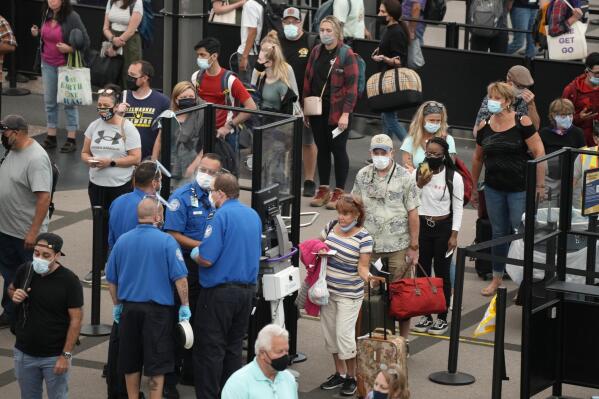
Travelers wear face coverings in the line for the south north security checkpoint in the main terminal of Denver International Airport Tuesday, Aug. 24, 2021, in Denver. Two months after the Sept. 11, 2001 attacks, President George W. Bush signed legislation creating the Transportation Security Administration, a force of federal airport screeners that replaced the private companies that airlines were hiring to handle security. (AP Photo/David Zalubowski)
Travelers wear face coverings in the line for the north security checkpoint in the main terminal of Denver International Airport Tuesday, Aug. 24, 2021, in Denver. Two months after the Sept. 11, 2001 attacks, President George W. Bush signed legislation creating the Transportation Security Administration, a force of federal airport screeners that replaced the private companies that airlines were hiring to handle security. (AP Photo/David Zalubowski)
Travelers wear face coverings in the line for the south security checkpoint in the main terminal of Denver International Airport Tuesday, Aug. 24, 2021, in Denver. Two months after the Sept. 11, 2001 attacks, President George W. Bush signed legislation creating the Transportation Security Administration, a force of federal airport screeners that replaced the private companies that airlines were hiring to handle security. (AP Photo/David Zalubowski)
Travelers wear face coverings in the queue for the south security checkpoint in the main terminal of Denver International Airport Tuesday, Aug. 24, 2021, in Denver. Two months after the Sept. 11, 2001 attacks, President George W. Bush signed legislation creating the Transportation Security Administration, a force of federal airport screeners that replaced the private companies that airlines were hiring to handle security. (AP Photo/David Zalubowski)
Travelers wear face coverings in the queue for the north security checkpoint in the main terminal of Denver International Airport Tuesday, Aug. 24, 2021, in Denver. Two months after the Sept. 11, 2001 attacks, President George W. Bush signed legislation creating the Transportation Security Administration, a force of federal airport screeners that replaced the private companies that airlines were hiring to handle security. (AP Photo/David Zalubowski)
A United Express jet taxis down a runway as a Southwest Airlines plane takes off in the background at Denver International Airport, Tuesday, Aug. 24, 2021, in Denver. Two months after the Sept. 11, 2001 attacks, President George W. Bush signed legislation creating the Transportation Security Administration, a force of federal airport screeners that replaced the private companies that airlines were hiring to handle security. (AP Photo/David Zalubowski)
A lone traveler wears a face covering as she stops to check the departure monitors across from the United Airlines ticketing counter in the main terminal of Denver International Airport Tuesday, Aug. 24, 2021, in Denver. Two months after the Sept. 11, 2001 attacks, President George W. Bush signed legislation creating the Transportation Security Administration, a force of federal airport screeners that replaced the private companies that airlines were hiring to handle security. (AP Photo/David Zalubowski)
- Copy Link copied
DALLAS (AP) — Ask anyone old enough to remember travel before Sept. 11, 2001, and you’re likely to get a gauzy recollection of what flying was like.
There was security screening, but it wasn’t anywhere near as intrusive. There were no long checkpoint lines. Passengers and their families could walk right to the gate together, postponing goodbye hugs until the last possible moment. Overall, an airport experience meant far less stress.
That all ended when four hijacked planes crashed into the World Trade Center towers, the Pentagon and a field in Pennsylvania.
The worst terror attack on American soil led to increased and sometimes tension-filled security measures in airports across the world, aimed at preventing a repeat of that awful day. The cataclysm has also contributed to other changes large and small that have reshaped the airline industry — and, for consumers, made air travel more stressful than ever.
Two months after the attacks, President George W. Bush signed legislation creating the Transportation Security Administration, a force of federal airport screeners that replaced the private companies that airlines were hiring to handle security. The law required that all checked bags be screened, cockpit doors be reinforced, and more federal air marshals be put on flights.
There has not been another 9/11. Nothing even close. But after that day, flying changed forever.
NEW THREATS, PRIVACY CONCERNS
Here’s how it unfolded.
Security measures evolved with new threats, and so travelers were asked to take off belts and remove some items from bags for scanning. Things that clearly could be wielded as weapons, like the box-cutters used by the 9/11 hijackers, were banned. After “shoe bomber” Richard Reid’s attempt to take down a flight from Paris to Miami in late 2001, footwear started coming off at security checkpoints.
Each new requirement seemed to make checkpoint lines longer, forcing passengers to arrive at the airport earlier if they wanted to make their flights. To many travelers, other rules were more mystifying, such as limits on liquids because the wrong ones could possibly be used to concoct a bomb.
“It’s a much bigger hassle than it was before 9/11 — much bigger — but we have gotten used to it,” Ronald Briggs said as he and his wife, Jeanne, waited at Dallas/Fort Worth International Airport for a flight to London last month. The north Texas retirees, who traveled frequently before the pandemic, said they are more worried about COVID-19 than terrorism.
“The point about taking shoes off because of one incident on a plane seems somewhat on the extreme side,” Ronald Briggs said, “but the PreCheck works pretty smoothly, and I’ve learned to use a plastic belt so I don’t have to take it off.”
The long lines created by post-attack measures gave rise to the PreCheck and Global Entry “trusted-traveler programs” in which people who pay a fee and provide certain information about themselves pass through checkpoints without removing shoes and jackets or taking laptops out of their bag.
But that convenience has come at a cost: privacy.
On its application and in brief interviews, PreCheck asks people about basic information like work history and where they have lived, and they give a fingerprint and agree to a criminal-records check. Privacy advocates are particularly concerned about ideas that TSA has floated to also examine social media postings (the agency’s top official says that has been dropped), press reports about people, location data and information from data brokers including how applicants spend their money.
“It’s far from clear that that has any relationship to aviation security,” says Jay Stanley, a privacy expert at the American Civil Liberties Union.
More than 10 million people have enrolled in PreCheck. TSA wants to raise that to 25 million.
The goal is to let TSA officers spend more time on passengers considered to be a bigger risk. As the country marks the 20th anniversary of the attacks, the TSA’s work to expand PreCheck is unfolding in a way privacy advocates worry could put people’s information at more risk.
At the direction of Congress, the TSA will expand the use of private vendors to gather information from PreCheck applicants. It currently uses a company called Idemia, and plans by the end of the year to add two more — Telos Identity Management Solutions and Clear Secure Inc.
Clear, which recently went public, plans to use PreCheck enrollment to boost membership in its own identity-verification product by bundling the two offerings. That will make Clear’s own product more valuable to its customers, which include sports stadiums and concert promoters.
“They are really trying to increase their market share by collecting quite a lot of very sensitive data on as many people as they can get their hands on. That strikes a lot of alarm bells for me,” says India McKinney, director of federal affairs for the Electronic Frontier Foundation, an advocacy group for digital rights.
TSA Administrator David Pekoske, though, sees Clear’s strategy as helping TSA. Says Pekoske: “We have allowed the vendors to bundle their offerings together with the idea that would be an incentive for people to sign up for the trusted-traveler programs.”
The TSA is testing the use of kiosks equipped with facial-recognition technology to check photo IDs and boarding passes rather than having an officer do it. Critics say facial-recognition technology makes errors, especially on people of color.
TSA officials told privacy advocates earlier this year that those kiosks will also pull photos taken when the traveler applied for PreCheck, McKinney says. That concerns her because it would mean connecting the kiosks to the internet — TSA says that much is true — and potentially exposing the information to hackers.
“They are totally focusing on the convenience factor,” McKinney says, “and they are not focusing on the privacy and security factors.”
‘SECURITY THEATER’?
Despite the trauma that led to its creation, and the intense desire to avoid another 9/11, the TSA itself has frequently been the subject of questions about its methods, ideas and effectiveness.
Flight attendants and air marshals were outraged when the agency proposed in 2013 to let passengers carry folding pocket knives and other long-banned items on planes again. The agency dropped the idea. And after another outcry, the TSA removed full-body scanners that produced realistic-looking images that some travelers compared to virtual strip searches. They were replaced by other machines that caused fewer privacy and health objections. Pat-downs of travelers are a constant complaint.
In 2015, a published report said TSA officers failed 95% of the time to detect weapons or explosive material carried by undercover inspectors. Members of Congress who received a classified briefing raised their concerns to Pekoske, with one lawmaker saying that TSA “is broken badly.”
Critics, including former TSA officers, have derided the agency as “security theater” that gives a false impression of safeguarding the traveling public. Pekoske dismisses that notion by pointing to the huge number of guns seized at airport checkpoints — more than 3,200 last year, 83% of them loaded — instead of making it onto planes.
Pekoske also ticked off other TSA tasks, including vetting passengers, screening checked bags with 3-D technology, inspecting cargo and putting federal air marshals on flights.
“There is an awful lot there that people don’t see,” Pekoske says. “Rest assured: This is not security theater. It’s real security.”
Many independent experts agree with Pekoske’s assessment, though they usually see areas where the TSA must improve.
“TSA is an effective deterrent against most attacks,” says Jeffrey Price, who teaches aviation security at Metropolitan State University of Denver and has co-authored books on the subject. “If it’s security theater, like some critics say, it’s pretty good security theater because since 9/11 we haven’t had a successful attack against aviation.”
This summer, an average of nearly 2 million people per day have flowed through TSA checkpoints. On weekends and holidays they can be teeming with stressed-out travelers. During the middle of the week, even at big airports like DFW, they are less crowded; they hum rather than roar. Most travelers accept any inconvenience as the price of security in an uncertain world.
Travel “is getting harder and harder, and I don’t think it’s just my age,” said Paula Gathings, who taught school in Arkansas for many years and was waiting for a flight to Qatar and then another to Kenya, where she will spend the next several months teaching. She blames the difficulty of travel on the pandemic, not the security apparatus.
“They are there for my security. They aren’t there to hassle me,” Gathings said of TSA screeners and airport police. “Every time somebody asks me to do something, I can see the reason for it. Maybe it’s the schoolteacher in me.”
THREATS FROM WITHIN
In 2015, a Russian airliner crashed shortly after taking off from Sharm El Sheikh in Egypt. American and British officials suspected it was brought down by a bomb .
It was, however, the exception rather than the rule. Even outside the United States, terror attacks on aviation since Sept. 11, 2001 have been rare. Is that because of effective security? Proving a negative, or even attributing it directly to a certain flavor of prevention, is always a dicey exercise.
And then there are the inside jobs.
— In 2016, a bomb ripped a hole in a Daallo Airlines plane shortly after takeoff, killing the bomber but 80 other passengers and crew survived. Somali authorities released video from Mogadishu’s airport that they said showed the man being handed a laptop containing the bomb.
— In 2018, a Delta Air Lines baggage handler in Atlanta was convicted of using his security pass to smuggle more than 100 guns on flights to New York.
— The following year, an American Airlines mechanic with Islamic State videos on his phone pleaded guilty to sabotaging a plane full of passengers by crippling a system that measures speed and altitude. Pilots aborted the flight during takeoff in Miami.
Those incidents highlight a threat that TSA needs to worry about — people who work for airlines or airports and have security clearance that lets them avoid regular screening. Pekoske says TSA is improving its oversight of the insider threat.
“All those folks that have a (security) badge, you’re right, many do have unescorted access throughout an airport, but they also go through a very rigorous vetting process before they are even hired,” Pekoske says. Those workers are typically reviewed every few years, but he says TSA is rolling out a system that will trigger immediate alerts based on law enforcement information.
With all the different ways that deadly chaos could happen on airplanes after 9/11, the fact remains: Most of the time, it hasn’t. The act of getting on a metal machine and rising into the air to travel quickly across states and countries and oceans remains a central part of the 21st-century human experience, arduous though it may be.
And while the post-9/11 global airport security apparatus has grown to what some consider unreasonable proportions, it will never neutralize all threats — or even be able to enforce the rules it has written. Just ask Nathan Dudney, a sales executive for a sporting goods manufacturer in Nashville who says he occasionally forgets about ammunition in his carry-on bag.
Sometimes it’s discovered, he says, and sometimes not. He understands.
“You can’t catch everything,” Dudney says. “They’re doing things to the best of their ability.”
David Koenig, based in Dallas, covers air travel and the airline industry for The Associated Press. Follow him on Twitter at http://twitter.com/airlinewriter
- International
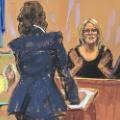
Trump's hush money trial

Israel-Hamas war
US marks 20th anniversary of 9/11
By Fernando Alfonso III , Adrienne Vogt and Melissa Macaya, CNN
How the 9/11 terror attacks unfolded in New York City, DC and Pennsylvania
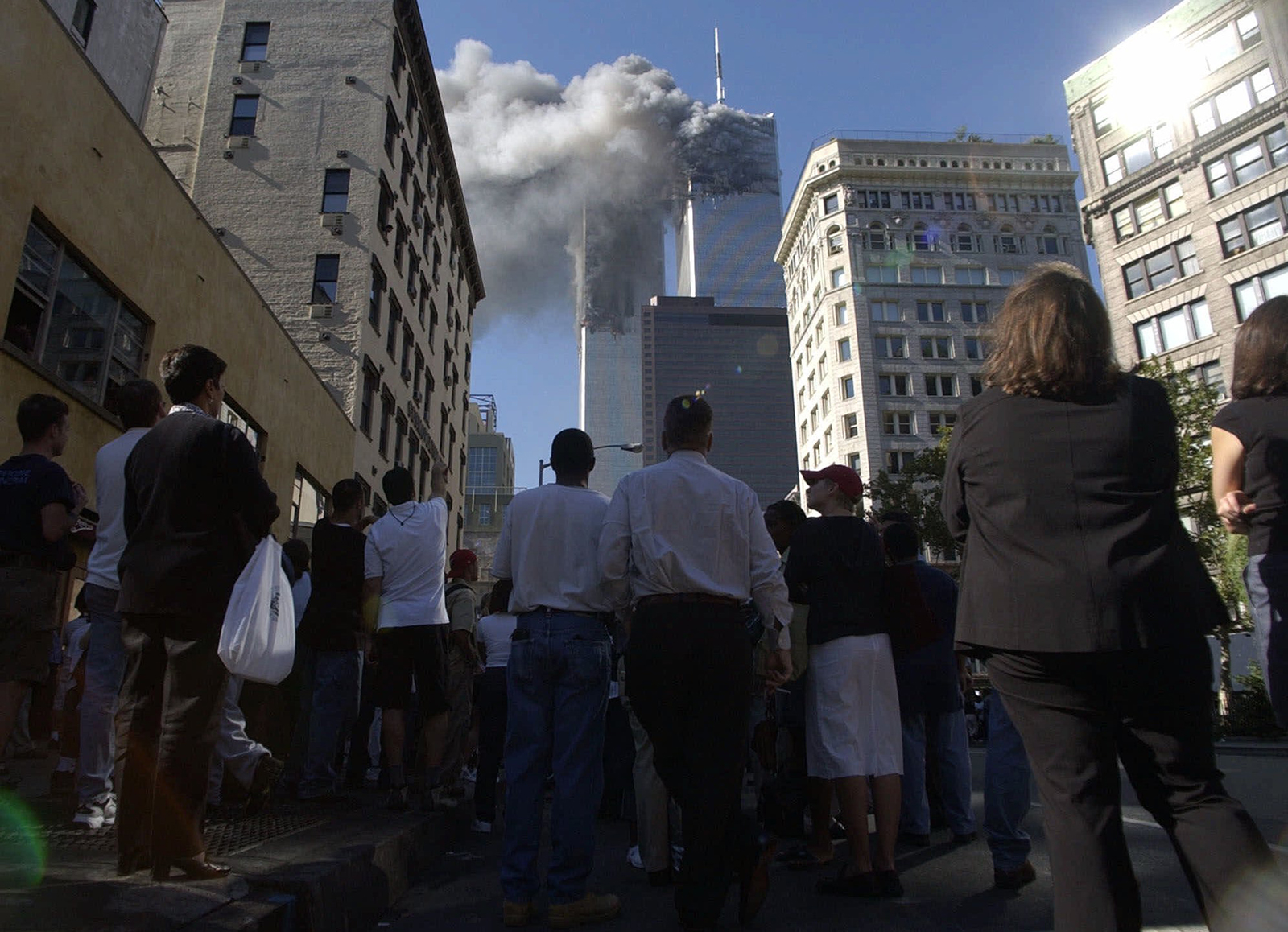
Nineteen men hijacked four fuel-loaded US commercial airplanes bound for west coast destinations on Sept. 11, 2001.
A total of 2,977 people were killed in New York City, Washington, DC and outside of Shanksville, Pennsylvania.
Of those who perished during the initial attacks and the subsequent collapses of the Towers, 343 were New York City firefighters, 23 were New York City police officers and 37 were officers at the Port Authority.
Near Shanksville, Pennsylvania, 40 passengers and crew members aboard United Airlines Flight 93 died when the plane crashed into a field. It is believed that the hijackers crashed the plane in that location, rather than their unknown target, after the passengers and crew attempted to retake control of the flight deck.
Here's a timeline of how the events unfolded that day:
- 8:46 am ET - American Airlines Flight 11 (traveling from Boston to Los Angeles) strikes the North Tower of the World Trade Center in New York City.
- 9:03 am ET - United Airlines Flight 175 (traveling from Boston to Los Angeles) strikes the South Tower of the World Trade Center in New York City.
- 9:17 am ET - The Federal Aviation Administration shuts down all New York City area airports.
- 9:30 am ET - Then-President Bush, speaking in Sarasota, Florida, says the country has suffered an "apparent terrorist attack."
- 9:37 am ET - American Airlines Flight 77 (traveling from Dulles, Virginia, to Los Angeles) strikes the Pentagon Building in Washington.
- 9:59 am ET - South Tower of WTC collapses in approximately 10 seconds.
- 10:03 am ET - United Airlines Flight 93 (traveling from Newark, New Jersey, to San Francisco) crashes in a field near Shanksville, Pennsylvania.
- 10:28 am ET - North Tower of WTC collapses. The time between the first attack and the collapse of both World Trade Center Towers is 102 minutes.
See a full chronology of events here.
White House previews Biden's 9/11 remembrance video and details why he won't speak today
From CNN's Jasmine Wright
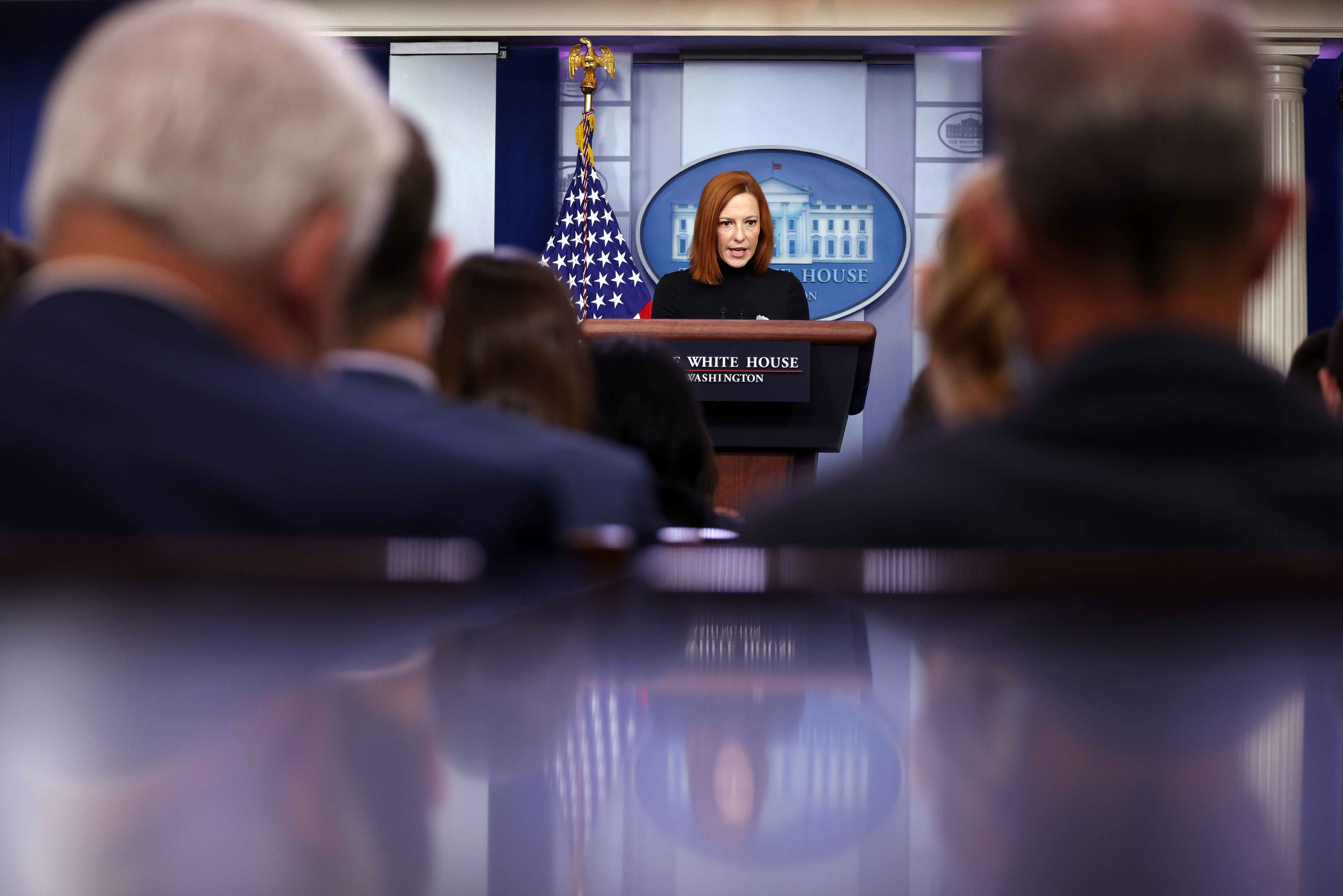
White House press secretary Jen Psaki said President Biden will not speak on Sept. 11 because he “felt it was important to visit,” the three remembrance sites in in New York, Pennsylvania and Virginia.
Instead, the White House will release a video of Biden to commemorate the 20th year in advance of his trip.
“The President felt it was important to visit each of these three sites to commemorate the lives lost, the sacrifices made, on a day that has impacted millions of people across the country but certainly many people in those communities. In order to do that, he's attending a ceremony were up several other former presidents and prominent officials are going to be hearing the names of the those lives that were lost around that period of time,” Psaki said, remarking that there won’t be a lengthy speaking period.
“Then he's going to be laying wreaths to commemorate the lives and honor those whose lives were lost. We're releasing the video today because we want you to hear from him and he wants the American people to hear from him directly on what 9/11 means to him 20 years later.”
Psaki would not read out what calls Biden has made in the lead-up to 9/11 or how he’s prepared his remarks.
Earlier, Psaki said Biden would convey in the video, “the importance of unity,” and how he first learned of the attack.
Biden and former Presidents Obama, Clinton and Bush to travel to sites of 9/11 attacks
From CNN's DJ Judd
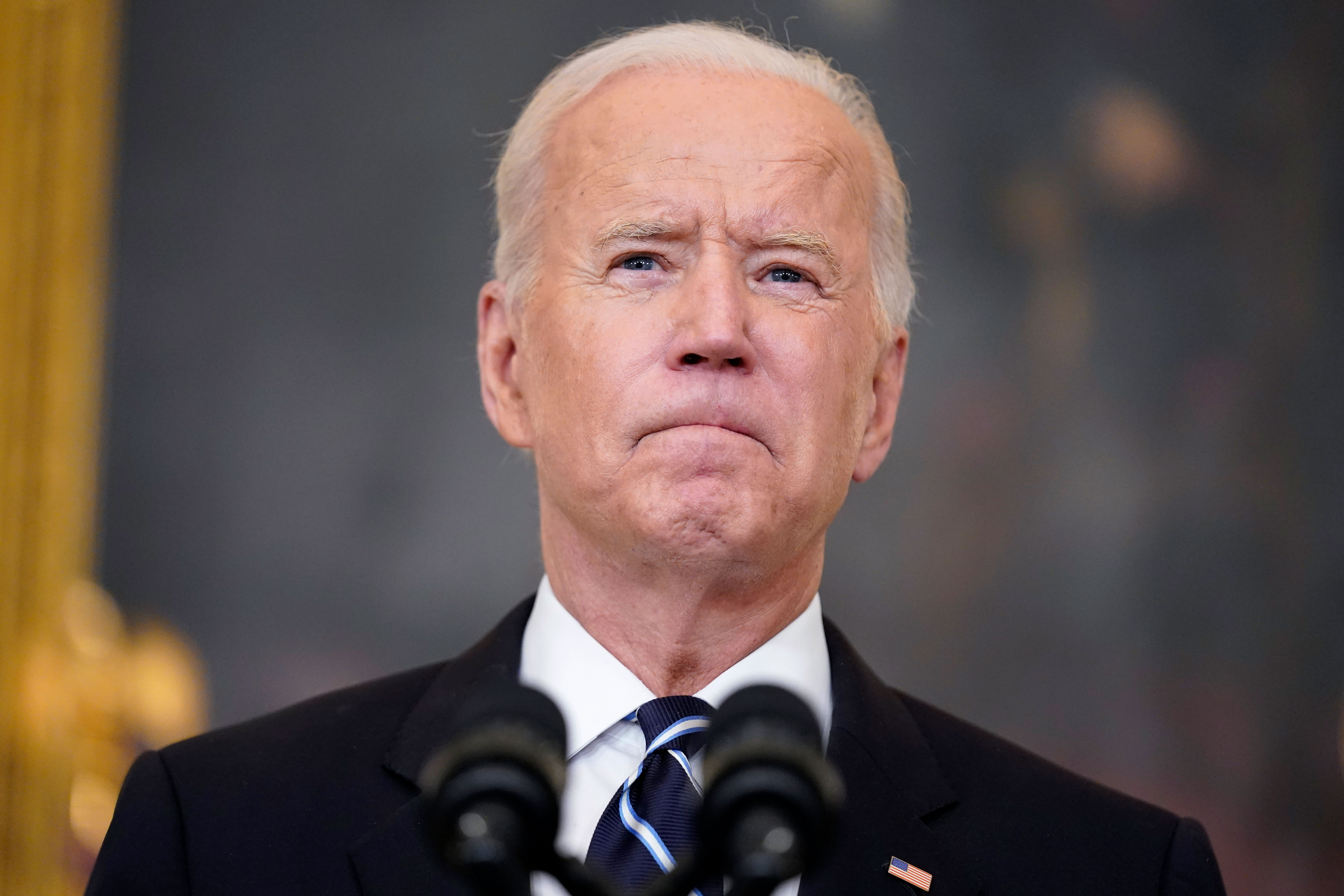
President Biden and first lady Jill Biden will travel to all three sites of the 9/11 terrorist attacks today, marking the 20th anniversary of the deadly day, according to the White House.
The President and first lady will visit New York City, Shanksville, Pennsylvania, and the Pentagon in Arlington, Virginia.
Vice President Kamala Harris and second gentleman Doug Emhoff will travel to Shanksville, the site of the United Flight 93 crash, for a separate event, before joining the President and first lady at the Pentagon.
Former President Barack Obama and former first lady Michelle Obama will attend the remembrance ceremony in New York, an Obama spokesperson tells CNN.
Former President George W. Bush and former first lady Laura Bush will also travel to Shanksville. The George W. Bush Presidential Center announced the 43rd President would deliver keynote remarks in a ceremony open to the families of those killed on United Flight 93 and invited guests.
Former president Bill Clinton and former Democratic presidential nominee Hillary Clinton will attend the 9/11 remembrance ceremony in New York City on Saturday, according to each Clinton's spokesperson.
CNN's Dan Merica contributed to this post.
Please enable JavaScript for a better experience.
- History Classics
- Your Profile
- Find History on Facebook (Opens in a new window)
- Find History on Twitter (Opens in a new window)
- Find History on YouTube (Opens in a new window)
- Find History on Instagram (Opens in a new window)
- Find History on TikTok (Opens in a new window)
- This Day In History
- History Podcasts
- History Vault
World Trade Center
By: History.com Editors
Updated: July 18, 2023 | Original: December 3, 2009

The iconic twin towers of downtown Manhattan’s World Trade Center were a triumph of human imagination and will. Completed in 1973, the towers stood at 110 stories each, accommodating 50,000 workers and 200,000 daily visitors in 10 million square feet of space. They were the hub of the bustling Financial District, a top tourist attraction and a symbol of New York City’s–and America’s–steadfast devotion to progress and the future. On September 11, 2001, the World Trade Center became the target of a massive terrorist attack that took the lives of nearly 3,000 people. The disaster also radically altered the skyline of New York City, destroying the twin columns of glass and steel that over the years had come to embody the city itself.
World Trade Center: A Dream Is Born
The 1939 New York World’s Fair included an exhibit called the World Trade Center that was dedicated to the concept of “world peace through trade.” Seven years later, one of the exhibit’s organizers, Winthrop W. Aldrich, headed a new state agency with the proposed goal of creating a permanent trade exposition based in New York. Market research indicated that the city would benefit more by modernizing its ports, however, and the plan was soon scrapped.
Did you know? More than 10,000 workers were involved in building the World Trade Center complex.
Aldrich’s nephew, David Rockefeller, didn’t forget the idea. The grandson of Standard Oil founder John D. Rockefeller , David decided to revive the World Trade Center concept as the core of a revitalized lower Manhattan. In May 1959, Rockefeller formed the Downtown-Lower Manhattan Association, which planned a $250 million complex near the Fulton Fish Market on the East River, including a single 70-story office tower and several smaller buildings.

The Port Authority Signs On
For the resources and power to make the project work, Rockefeller turned to the Port of New York Authority. The Port Authority had been chartered in 1921 by New York and New Jersey to build and operate all transportation terminals and facilities within a 25-mile radius of the Statue of Liberty .
By 1960, after constructing the Lincoln Tunnel and the George Washington Bridge, the Port Authority was rapidly expanding its influence, with 5,000 employees and more than $1 billion in freight and transportation structures all presided over by its powerful director, Austin J. Tobin.
The Port Authority had just agreed to take over and renovate New Jersey ’s Hudson and Manhattan commuter railroad, the PATH (Port Authority Trans Hudson) train, built in 1908. The PATH terminal was on the west side of Lower Manhattan, and Tobin’s team decided to move the prospective trade center location from east to west, combining the two projects.
A region bounded by Vesey, Church, Liberty and West Streets–known as “Radio Row” for its many consumer electronics shops–would have to be razed for the trade center to be built. After a bitter legal battle with representatives of the Radio Row merchants, the Port Authority won the right to continue its plan.
Sights Set on Record-Breaking Height
By this time, the Port Authority had decided that the trade center should replace the 1,250-foot-high Empire State Building, built in 1931, as the world’s tallest building. To fulfill the Port Authority’s requirement, architect Minoru Yamasaki designed two towers of 110 stories each.
Instead of the traditional stacked glass-and-steel box construction of many New York skyscrapers, Yamasaki worked with structural engineers to come up with a revolutionary design: two hollow tubes, supported by closely spaced steel columns encased in aluminum. Floor trusses connected this exterior steel lattice to the central steel core of the building. In this way, the “skin” of the building would be strong enough that internal columns wouldn’t be necessary to hold it together.
Construction began in February 1967, after the Port Authority faced down criticism about the towers’ safety and viability from many powerful figures, including real estate tycoon (and Empire State Building owner) Lawrence Wien. Wien even ran an ad in the New York Times in May 1968 predicting that a commercial airliner was likely to fly into the towers.
Plans had already been made to guard against such an accident–which had happened in July 1945 with a smaller plane at the Empire State–and the towers were designed to be safe in a collision with a fully loaded 707 plane (the largest existing plane at the time). It was assumed such a plane would have to be lost in fog for such an event to occur; a terrorist attack was never envisioned.
Feats of Engineering at the World Trade Center

Because the ground in lower Manhattan was largely landfill, engineers would have to dig down 70 feet to reach bedrock. Excavating machines dug a three-foot-wide trench down to the bedrock, and as dirt and rock were removed, they were replaced by slurry: a mixture of water and bentonite, a type of clay that expands when wet to plug any hole along the side of the trench. Workers then lowered a 22-ton, seven-story-high steel cage into the trench and filled it with concrete by using a long pipe. As the concrete flowed in, it displaced the bentonite slurry.
By making more than 150 of these slurry trench segments, workers enclosed an area two blocks wide and four blocks long. Called the “bathtub,” it was used to seal the basements of the towers and keep water from the Hudson River out of the foundation.
All in all, one million cubic yards of landfill had to be removed. The Port Authority used this landfill to create the $90 million worth of land that would become Battery Park City. To piece the steel frame of the building together, engineers brought in Australian-made “kangaroo” cranes, self-powered cranes powered by diesel motors that could hoist themselves up as the building grew higher.
At the end of construction, these cranes had to be disassembled and brought down by elevator. When the towers were finished, each one would have 97 passenger elevators, capable of carrying loads of up to 10,000 pounds at speeds of up to 1,600 feet per minute. In all, the towers were assembled from more than 200,000 pieces of steel manufactured around the country, 3,000 miles of electrical wiring, 425,000 cubic yards of concrete, 40,000 doors, 43,600 windows and six acres of marble.
World Trade Center: A Dream Come True
The last piece of steel was put in place on the north tower (One World Trade Center) on December 23, 1970; the south tower (Two World Trade Center) was topped off in July of the next year. Construction went on until April 1973, when the five-acre outdoor plaza, dominated by a 25-foot-tall bronze sculpture by Fritz Koenig, was completed. At the official ribbon cutting ceremony on April 4, Governor Nelson Rockefeller (David’s brother) proclaimed triumphantly, “It’s not too often that we see a dream come true. Today, we have.”
At 1,360 feet, the World Trade Center towers were the tallest buildings in the world for less than a year; they were soon surpassed by Chicago’s Sears Tower. Still, the towers held an incomparable mystique. They inspired incredible stunts, beginning in August 1974, when Philippe Petit walked a high wire between the two towers .
In May 1977, George Willig earned himself the nickname of “the Human Fly” by hoisting himself to the top of the south tower using homemade climbing devices. The Port Authority loved these stunts because they endeared the towers to the public and made them seem like giant toys. They worked at turning the towers into an attraction, adding the Windows on the World restaurant, which opened on the 107th floor of the north tower in April 1976 and was an immediate hit.
By 1983, World Trade Center revenues had jumped to $204 million, and space was in high demand. Smaller importers-exporters were now being pushed out by rising rents, making way for major businesses.
1993 Bombing of the World Trade Center

The first major test of the trade center’s structural integrity came on February 26, 1993, when a bomb with the destructive power equal to 2,200 pounds of TNT exploded in the parking garage of the second floor basement of the north tower. The blast killed six people, injured more than 1,000 others and caused an estimated $600 million in damage. Six Islamic extremists were tried and convicted in connection with the plot.
The towers reopened 20 days after the bombing with new security measures in place, including restrictions to parking lot access and electronic identification badges for building tenants. Over the next eight years, the Port Authority spent a total of $700 million on renovations, with safety upgrades like battery-powered stairway lights and a separate emergency command center in each building. Mayor Rudy Giuliani set up a high-tech emergency operations command center, dubbed “the Bunker,” at 7 World Trade Center, a 47-story office building adjoining the towers.
The World Trade Center on September 11th
In July 2001, just two months before the terrorist attacks of September 11, the Port Authority agreed to lease the twin towers to Larry Silverstein, a New York City developer. Silverstein agreed to pay the equivalent of $3.2 billion over the next 99 years. At the time, over 99 percent of the 10.4 million square feet controlled by the Port Authority was occupied.
The impact of the two planes that hit the World Trade Center towers on September 11, 2001, was more devastating than any of the building’s designers and engineers had ever imagined. The first plane ripped a hole in the north tower from the 94th to the 98th floors, causing massive structural damage and igniting some 3,000 of the 10,000 gallons of jet fuel the plane was carrying. The second plane hit the south tower at an even faster speed, striking the corner and gashing the building from the 84th to the 78th floors.
The heroic efforts of the city’s fire and police departments and other emergency services helped 25,000 people escape from the site on 9/11 before the unthinkable occurred. The damage done at each point of impact forced the physical weight of the towers to be redistributed, and the undamaged part below the hole had to support the floors above. At the same time, the fires raging in both buildings weakened the steel trusses holding up each floor. With damage to a greater number of floors lower down on the building, the south tower gave way first, crumbling to the ground at 9:59 a.m., only 56 minutes after being hit. The north tower collapsed less than a half hour later, at 10:28 a.m.
Debris from the falling towers ignited fires in the remaining buildings of the trade center complex, including 7 World Trade, which burned for most of the day before collapsing at 5:20 p.m. Overwhelmed by horror, shock and grief, New Yorkers and people around the world trained their eyes on “ Ground Zero ,” where the fall of a treasured icon of American industry and ingenuity had left a gaping hole in the sky.
One World Trade Center
That hole in the sky would eventually be filled by One World Trade Center , or “The Freedom Tower,” which rises even higher than the Twin Towers it was built to honor. At a symbolic 1,776 feet tall, One World Trade is the tallest building in the United States and Western Hemisphere, overtaking Sears Tower in Chicago. Built on the original 6 World Trade Center, it was originally designed by architect Daniel Libeskind to be an asymmetrical tower inspired by the Statue of Liberty .
In 2004, architect David Childs, known for designing both the Burj Khalifa and the Willis Tower, took over. The cornerstone was laid on July 4, 2004, but the building did not open until November 3, 2014 . Architecture critic Kurt Andersen wrote, “The fact that it’s taken more than a decade to finish, I think —the gradualism—makes that sense of emblematic rebirth more acute and irresistible.”
One World Trade is 104 stories tall and has three million square feet of office space topped off by One World Observatory, an observation deck, bar, and restaurant open to the pubic. It spans from floors 100-102 and offers visitors panoramic views of New York City.
Rebuilding the World Trade Center
A new tower at 7 World Trade Center opened in 2006. The $2 billion 4 World Trade Center followed in 2013. The World Trade Center Oculus, a glass and steel transit concourse and shopping center designed by the Spanish architect Santiago Calatrava, opened to the public in 2016, while the 1,155 foot tall 3 World Trade Center opened in 2018. Silverstein’s 2 World Trade Center and 5 World Trade Center remain incomplete.
The rebuilt 16-acre World Trade Center site also includes the National 9/11 Memorial designed by Michael Arad. His design, “Reflecting Absence,” includes two reflecting pools in the footprints of the former Twin Towers surrounded by bronze panels with the names of all 2,983 victims of the 1993 and 2001 World Trade Center attacks.

HISTORY Vault: 9/11 Documentaries
Explore this collection of extraordinary documentary films about one of the most challenging days in U.S. history.

Sign up for Inside History
Get HISTORY’s most fascinating stories delivered to your inbox three times a week.
By submitting your information, you agree to receive emails from HISTORY and A+E Networks. You can opt out at any time. You must be 16 years or older and a resident of the United States.
More details : Privacy Notice | Terms of Use | Contact Us
Remembering the Victims: These Are the People Who Died in the Sept. 11 Attacks
Nearly 3,000 people were killed at the world trade center, the pentagon and in shanksville, pennsylvania, published september 9, 2021 • updated on september 11, 2023 at 12:32 pm.
Hijacked airplanes smashed into New York City's World Trade Center and the Pentagon in Washington, D.C., on Sept. 11, 2001, in terrorist attacks carried out by the Islamist group al-Qaida. The World Trade Center’s Twin Towers collapsed less than 90 minutes later.
Nearly 3,000 people were killed in the attacks.
A fourth airplane also headed to the U.S. capital crashed into a Pennsylvania field outside of Shanksville, when the passengers fought the hijackers in an attempt to regain control of the cockpit.
Nineteen hijackers died after they commandeered the planes to use as weapons.
The leader of al-Qaida, Osama bin Laden, had created the extremist organization in Afghanistan after the 1989 withdrawal of Soviet troops from the country. He opposed the presence of U.S. troops in Saudi Arabia and American policy in the Middle East among other grievances against the West. Bin Laden was killed during the Obama administration by a U.S. attack on the house where he was hiding in Pakistan.
The man accused of being the mastermind behind the attacks is Khalid Sheikh Mohammed, who is still being held at Guantanamo Bay with four others, charged with conspiracy, murder and terrorism. They face the death penalty. Jury selection for a trial before a military tribunal was to have begun in January but has been delayed because of the coronavirus pandemic and other issues.
Sources: NBC New York, The National 9/11 Pentagon Memorial , Friends of Flight 93
Design and development by Nelson Hsu Editing by Noreen O'Donnell
Help inform the discussion
Timeline: The September 11 terrorist attacks
The day that defined the beginning of the 21st Century for Americans
On September 11, 2001, 2,977 people were killed in the deadliest terrorist attacks in American history.
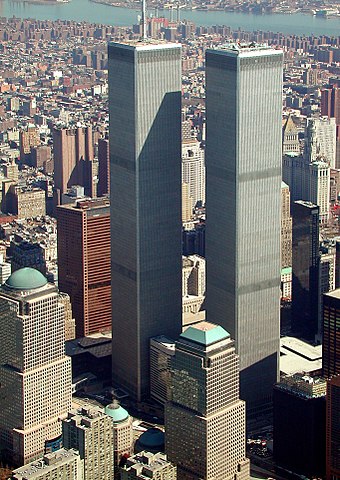
The moment shocked the nation. Two planes, hijacked by Islamic jihadists vowing death to all Americans, plowed into both towers at the World Trade Center in New York. Another plane was flown into the Pentagon in Washington, DC. A fourth plane, presumably headed for the White House or the U.S. Capitol, was heroically diverted by passengers and ended up crashing in an empty field in Pennsylvania. After reports of the first plane hitting the North Tower, millions watched the second plane hit the South Tower on live television.
It was a terrifying, startling, and humbling event for the country. The 9/11 attacks were the deadliest on American soil since the shock attack at Pearl Harbor 60 years before, and the sense of outrage was reminiscent of that moment. The attacks in New York occurred in the country’s busiest city on a busy workday. And the staggered nature of the attacks meant that news footage captured almost everything as it happened, ensuring that millions of Americans saw the events precisely as they unfolded.

September 11, 2001
5:45 AM – Mohamed Atta and Abdul Aziz al-Omari, two of the intended hijackers, pass through security at the Portland International Jetport in Maine. They board a commuter flight to Boston Logan International Airport, they then board American Airlines Flight 11 .
7:59 AM – Flight 11 takes off from Boston, headed for Los Angeles, California. There are 76 passengers, 11 crew members, and 5 hijackers on board.
8:15 AM – United Airlines Flight 175 takes off from Boston, also headed for Los Angeles. There are 51 passengers, 9 crew members, and 5 hijackers on board.
8:19 AM – A flight attendant on Flight 11 , Betty Ann Ong, alerts ground personnel that a hijacking is underway and that the cockpit is unreachable.
8:20 AM – American Airlines Flight 77 takes off from Dulles, outside of Washington, DC, headed for Los Angeles. There are 53 passengers, 6 crew members, and 5 hijackers on board.
8:24 AM – Mohamed Atta, a hijacker on Flight 11 , unintentionally alerts air controllers in Boston to the attack. He meant to press the button that allowed him to talk to the passengers on his flight.
8:37 AM – After hearing the broadcast from Atta on Flight 11 , Boston air traffic control alerts the US Air Force’s Northeast Defense Sector, who then mobilize the Air National Guard to follow the plane.
8:42 AM – United Flight 93 takes off from Newark, New Jersey, after a delay due to routine traffic. It was headed for San Francisco, California. There are 33 passengers, 7 crew members, and 4 hijackers are on board.
8:46 AM – Flight 11 crashes into the World Trade Center’s North Tower. All passengers aboard are instantly killed, and employees of the WTC are trapped above the 91 st floor.
9:03 AM – Flight 175 crashes into the WTC’s South Tower. All passengers aboard are killed instantly and so are an unknown number of people in the tower.
9:05 AM – President George W. Bush, in an elementary school classroom in Florida, is informed about the hit on the second tower. His chief of staff, Andrew Card, whispers the chilling news into the president’s ear. Bush later wrote about his response: “I made the decision not to jump up immediately and leave the classroom. I didn’t want to rattle the kids. I wanted to project a sense of calm… I had been in enough crises to know that the first thing the leader has to do is to project calm.” ( Miller Center )

9:28 AM – Hijackers attack on Flight 93 .
9:37 AM – Flight 77 crashes into the Pentagon. All passengers aboard are instantly killed and so are 125 civilian and military personnel in the building.
9:45 AM – US airspace is shut down under Operation Yellow Ribbon. All civilian aircraft are ordered to land at the nearest airport.

9:55 AM – Air Force One with President George W. Bush aboard takes off from Florida.
9:57 AM – Passengers aboard Flight 93 begin to run up toward the cockpit. Jarrah, the pilot, begins to roll the plane back and forth in an attempt to destabilize the revolt.
9:59 AM – The South Tower of the World Trade Center collapses.
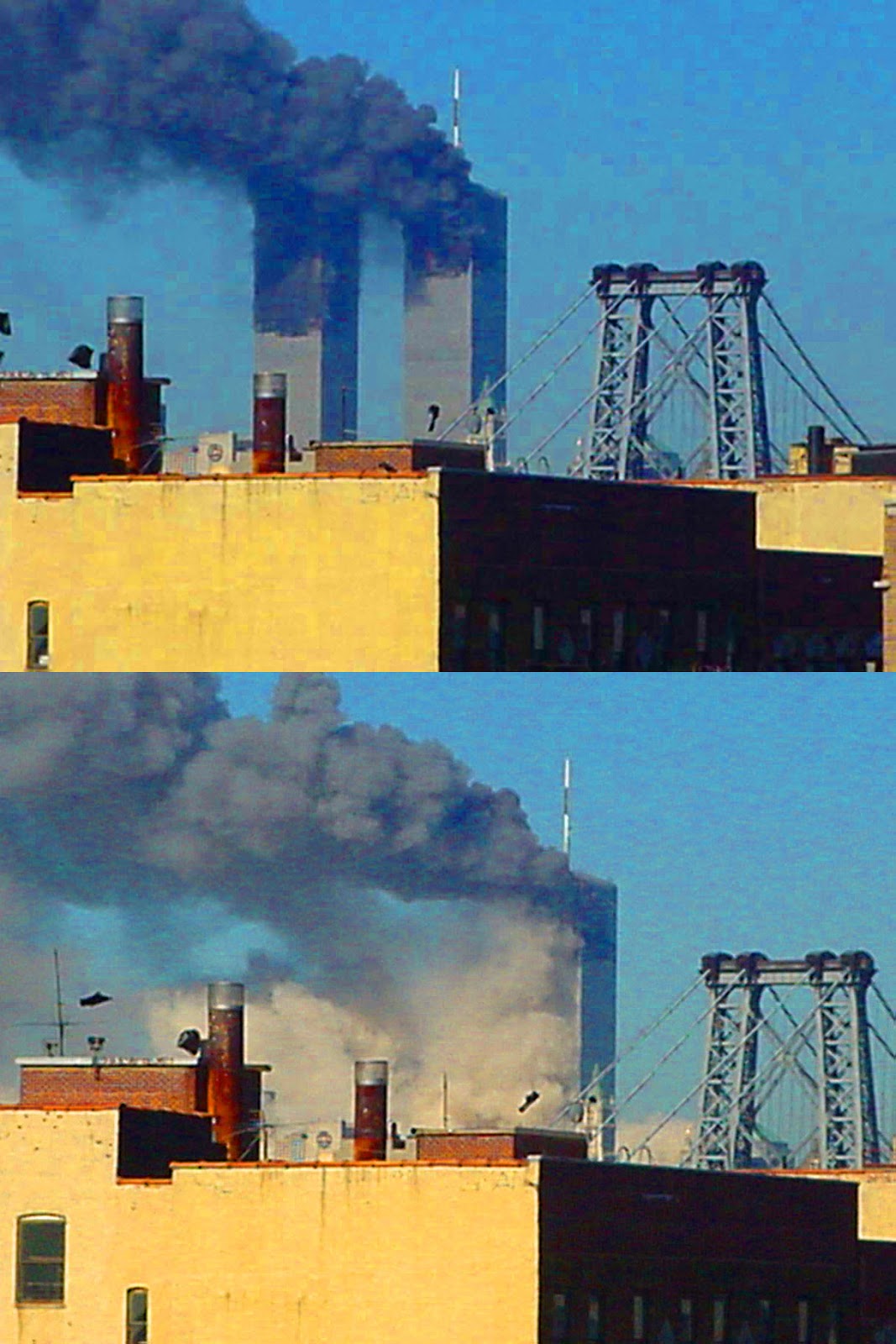
10:02 AM – Flight 93 plows into an empty field in Shanksville, Pennsylvania. Although its ultimate target is unknown, it was likely heading for either the White House or the US Capitol.
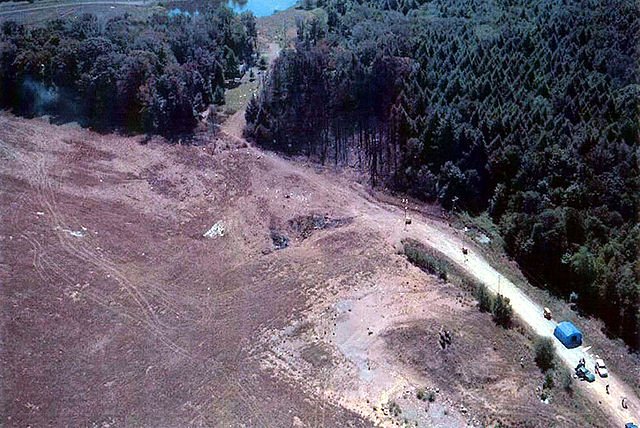
10:18 AM – President Bush authorizes any non-grounded planes to be shot down. At that time, all four hijacked planes had already crashed but the president’s team was operating under the impression that Flight 93 was still in the air.
10:28 AM – The North Tower of the World Trade Center collapses.
10:53 AM – Secretary of Defense Donald Rumsfeld orders the US military to move to a higher state of alert, going to DEFCON 3.
11:45 AM – Air Force 1 lands at Barksdale Air Force Base near Shreveport, Louisiana.
12:15 PM – Airspace in the United States is completely free of all commercial and private flights.
1:30 PM – Air Force 1 leaves Barksdale.
2:30 PM – Rudy Giuliani, the mayor of New York City, visits the fallen Twin Towers of the World Trade Center at what becomes known as Ground Zero.
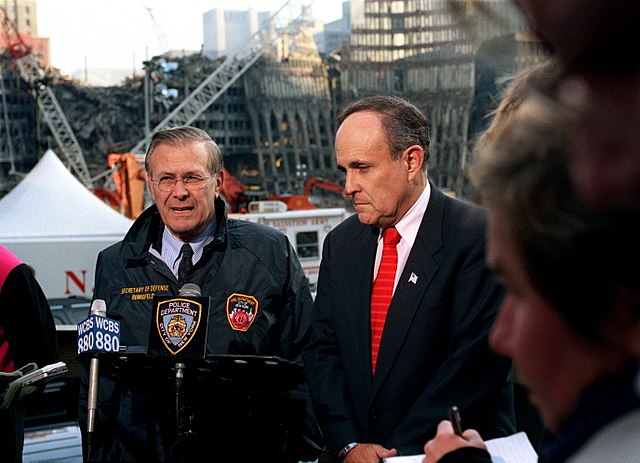
3:00 PM – Air Force 1 lands at Offutt Air Force Base in Nebraska, and President Bush is immediately taken to a secure bunker that is capable of withstanding a nuclear attack.
4:30 PM – Air Force 1 leaves Offutt and heads back toward Andrews Air Force base near Washington, DC.

5:30 PM – Building 7 of the World Trade Center collapses.
8:30 PM – President Bush addresses the nation.
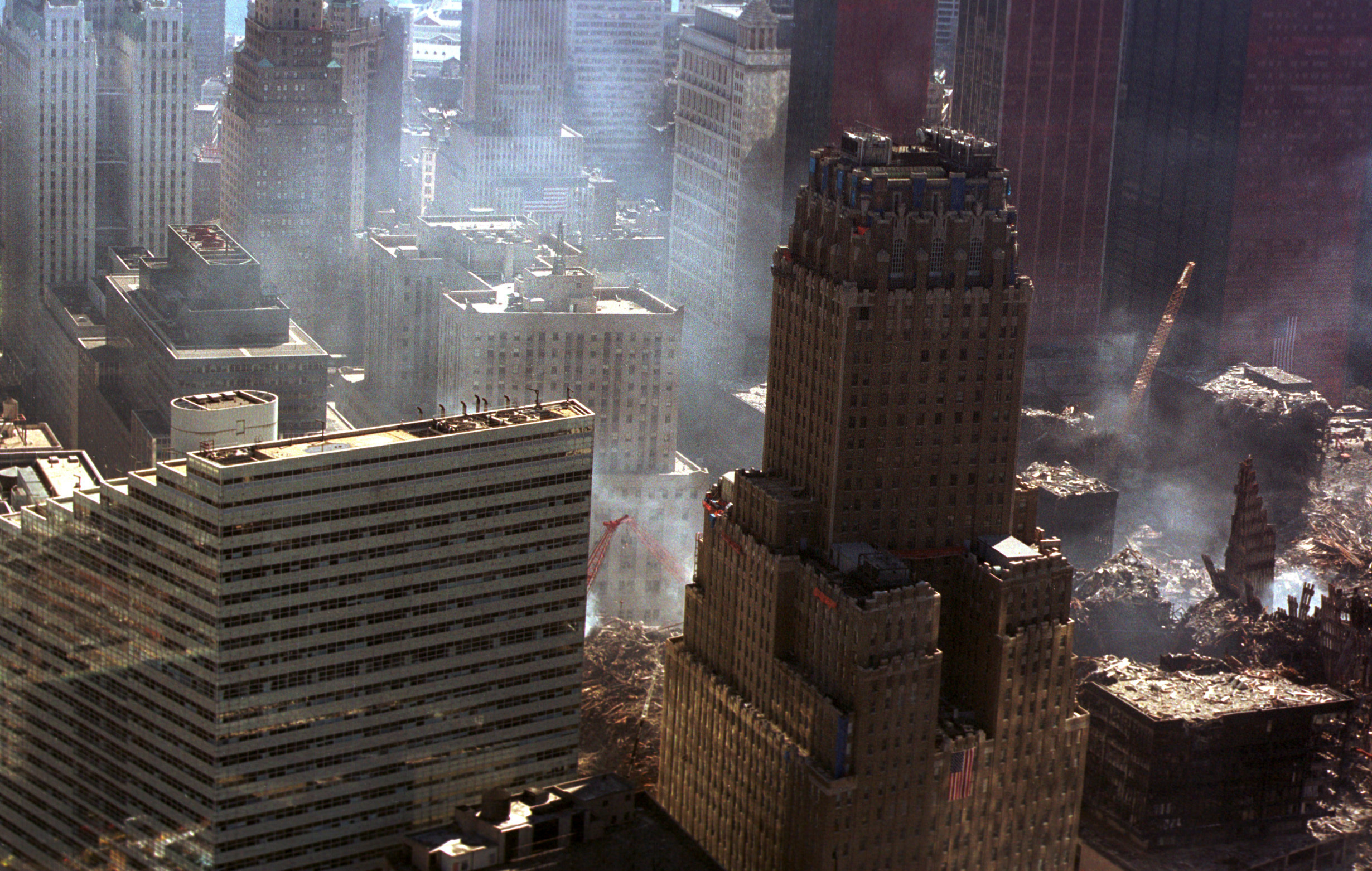
Although to many Americans 9/11 seemed like a random act of terror, the roots of the event had been developing for years. A combination of factors that coalesced in the late 1990s led the catastrophic event. These factors included regional conditions in the Middle East that motivated the perpetrators, as well as intelligence lapses and failures that left the United States vulnerable.
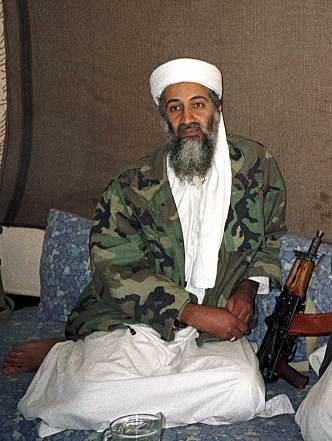
Osama Bin Laden was relatively unknown in the United States before 9/11, even as he was amassing popularity, followers, and fame in the Middle East during the 1990s. In 1988, he was one of the founders of al Qaeda, a militant Islamic terrorist organization that organized and carried out the 9/11 attacks. Bin Laden called for indiscriminate killing of all Americans who, he claimed, were “the worst thieves in the world today” (9/11 Report, page 47). It was the perfect historical moment for that rallying cry.
Throughout the 20th century, a wave of secular, nationalist revolutions swept through the Middle East, taking root in Egypt, Libya, Iraq, Yemen, and other countries. While these movements were awash in promising ideology, the new regimes quickly became autocratic and suppressed dissent. Their critics turned to violent revolution to express their dissatisfaction with the secular governments.
At the same time, social malaise, especially among young men who were struggling to find decent jobs and start their own families in corrupt oil states, provided easy targets for radicalization. Bin Laden’s message that America was the “head of the snake” and the root of all society’s problems resonated well with the discontent.
By the mid-1990s, Bin Laden was the head of al Qaeda, a multifaceted and highly developed terrorist network carrying out attack after attack on Americans in the Middle East. It was a new type of terrorism to which the US intelligence agencies struggled to adapt. Much of the intelligence community had not even imaged the specific type of hijacking and terrorism carried out on 9/11. They were preparing for threats such as the 1993 bombing of the World Trade Center and bombing in 2000 of the USS Cole .
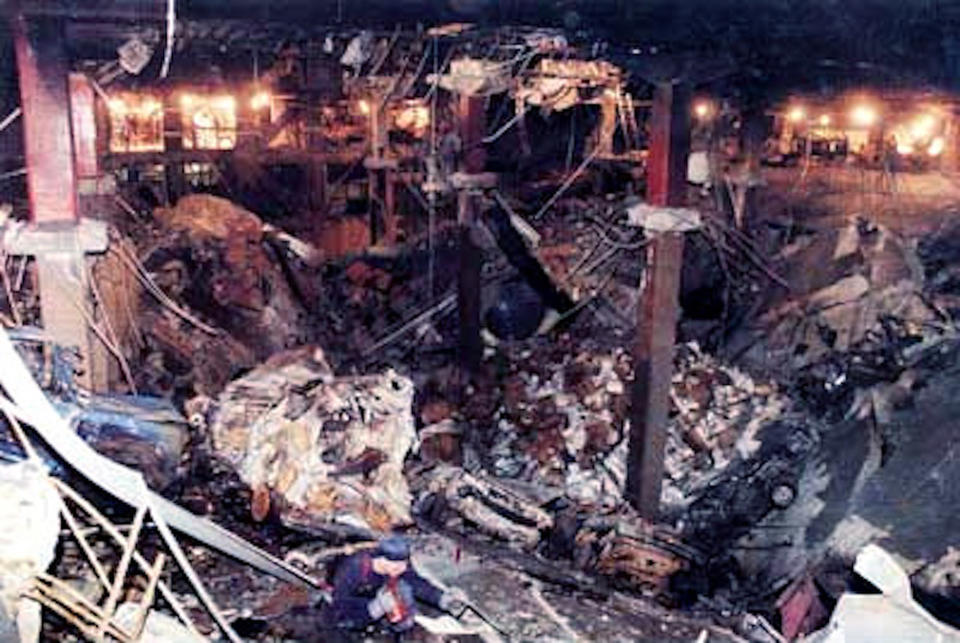
Much of the intelligence community’s focus was on reactive law enforcement activity rather than proactive countering of terrorism. A telling quote from the 9/11 commission report focuses on the lack of a proactive response: “The process was meant, by its nature, to mark for the public as the events finished – case solved, justice done. It was not designed to ask if the events might be harbingers of worse to come. Nor did it allow for aggregating and analyzing facts to see if they could provide clues to terrorist tactics more generally – methods of entry and finance, and mode of operation inside the United States” (Commission Report, p. 73).
Bin Laden had amassed substantial power due to conditions in the Middle East as well as his charismatic leadership, and the US intelligence community was underprepared for a 9/11 style attack. In the aftermath of 9/11, these two factors continued to affect US policy in the Middle East, particularly in Iraq.
The immediate response to 9/11 was the George W. Bush administration’s War on Terror, which began in Afghanistan as a retaliation against al Qaeda for carrying out the attack. The Bush administration soon expanded the War on Terror into Iraq, and the consequences of these wars continue to affect the Middle East to this day. Almost 20 years later, the United States is still at war in both Afghanistan and Iraq.
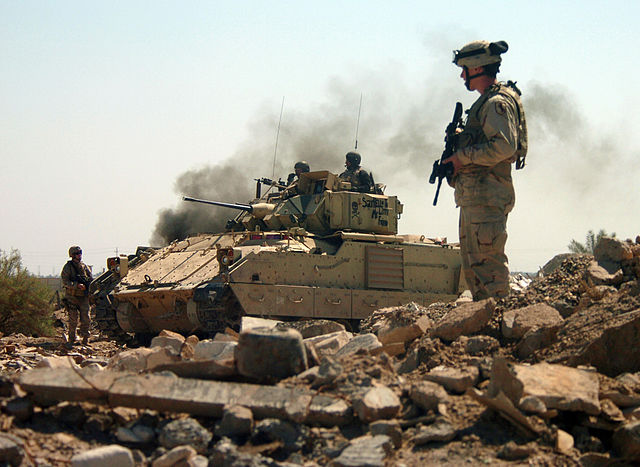
There were domestic long-term effects of 9/11 as well. Thousands of people struggle with cancer and lasting chronic health problems relating to the toxicity from Ground Zero, the site where the Twin Towers used to stand. The September 11 attacks also changed American air travel as airlines began to require stringent security checks designed to prevent the types of weapons the hijackers used from slipping through.
Finally, the 9/11 attacks resulted in changes to the federal government and an expansion of executive power. A new cabinet department, the Department of Homeland Security, was created, and the intelligence community was consolidated under the Director of National Intelligence to improve coordination between various agencies and departments. New legislation such as the USA Patriot Act expanded domestic security and surveillance, disrupted terrorist funding by cracking down on activities such as money laundering, and increased efficiency within the U.S. intelligence community.
The tragedy of September 11, 2001 will never be forgotten, and the aftermath is still continuing to unfold. The 9/11 Memorial and Museum opened on the site of the former World Trade Center on September 11, 2011, and features reflecting pools in the footprints of where the Twin Towers once stood.
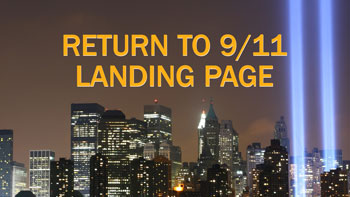
Katherine Huiskes
Katherine Huiskes is a member of UVA's class of 2021, where she studied foreign affairs and history, with a particular interest in policymaking, cybersecurity, and military budgeting.
More on the presidency of George W. Bush
Read the 9/11 commission report, click here to read the report, more about the september 11 attacks, the road to 9/11, the road from 9/11, lessons learned from september 11, the roots of september 11: america and afghanistan, world politics after september 11: a clash of civilizations.
Analysis: How 9/11 and its fallout reshaped travel
- Share on WhatsApp
- Share by email
Saturday marks two decades since the terror attacks in the US. Ian Taylor looks at how the fallout from that day reshaped travel restrictions but did little to slow global growth in tourism
The 20th anniversary of September 11 will be marked in ways no doubt not intended when President Biden confirmed the US withdrawal from Afghanistan.
The attacks by hijacked aircraft on New York’s Twin Towers and the Pentagon killed almost 3,000 people and triggered a 20-year war after the US and Nato invaded Afghanistan and in 2003 went to war in Iraq.
The impact on travel was far less deadly, but the legacy of the attacks provides pointers to what we might expect as the world learns to live with Covid-19.
The immediate impact was stunning, with US aviation grounded. Within days, industry leaders were warning of failures. Iata chairman Leo Mullin warned the US government: “At least three of our major members are on the brink.” The increase in insurance premiums alone threatened to bankrupt the sector.
The US Department of Transportation (DoT) subsequently reported: “It took until July 2004 for the industry to match and surpass pre-9/11 levels.”
In the event, there were no major US airline failures. But over four years, every major US international carrier bar American Airlines passed through bankruptcy protection. Employment in the sector fell by 28%, or 150,000 jobs.
The DoT reported in 2005: “Today’s airline industry presents a different picture than prior to September 11, with more passengers flying low-cost carriers, fewer empty seats and a smaller workforce. Available seats only recently reached pre-9/11 peaks. In contrast, air passenger travel reached its pre-9/11 peak in July 2004 and continued to grow.”
In Europe, Belgian carrier Sabena collapsed in November 2001 after part-owner Swissair failed to offer a bailout. Swissair followed, taking down France’s second-largest carrier Air Liberté, which it part-owned. However, Swissair-Sabena had been struggling for years. Out of the failures, Swissair subsidiary Crossair emerged as Swiss and Sabena gave way to Brussels Airlines – both now part of the Lufthansa Group.
Impact in UK
You would be hard-pressed to claim 9/11 had a dire impact on UK outbound travel. ONS figures suggest a mere slowdown in growth of outbound holidays between 2000 and 2004.
Overseas holiday numbers rose from 36.7 million in 2000 to 38.7 million in 2001 and to almost 40 million in 2002, then passed 41 million in 2003 and reached almost 43 million in 2004.
UK airport passenger numbers rose from 168 million in 1999 to 180 million in 2001 (+7%) and 199 million in 2003 (+10.5%) also suggesting no great detriment. This was despite the international tension through 2002 as the US and UK prepared for an invasion of Iraq, launched in March 2003.
There was a dip in European air traffic in this period, with the number of commercial flights falling from 8.7 million in 2000 to 8.5 million in 2002.
UK data for overseas business travel suggests the source of the decline, with outbound corporate trips falling 11% between 2000 and 2003, reflecting the impact on transatlantic traffic. Indeed, ONS data suggests there was no overall growth in corporate trips in the decade to 2009.
A dip in overseas visitors to the UK is also clear between 2000 and 2003, reflecting the loss of US travellers post 9/11.
But a more severe impact was anticipated. The Air Travel Trust (ATT) report for the year to March 2002 noted the months following September 11 were “some of the most demanding in recent years” and had “a significant effect on the level and timing of bookings, with a consequent impact on the viability of some Atol holders”.
By March 2003, 23 Atol holders had folded, double the previous year’s total. However, the ATT pointed out the increase was still one of the lowest failure rates since 1989 and “only brings the rate back to the level of the mid-to-late 1990s”.
The next year, to March 2003, saw just nine failures – a new low despite the build-up to the invasion of Iraq.
There was one notable exception. MyTravel, or Airtours as it was known until 2002, was the UK’s second-biggest travel group. Its fortunes plunged spectacularly in 2002 amid a series of profit warnings but also, crucially, the exposure of serious irregularities in its accounts. The group’s share value collapsed. Its £1.3 billion debt dwarfed its value and it was saved only by the CAA declining to pull its Atol and by wiping out its creditors by swapping its debt for equity.
The group downsized and restructured over several years but never recovered and those running it were grateful to merge with Thomas Cook in 2007.
Twelve years on, MyTravel returned to haunt Thomas Cook when in May 2019 Cook was compelled to report a £1.5 billion half-year loss owing to a £1.1 billion impairment in the value of MyTravel which it had retained on the books. The group subsequently went into liquidation.
Impact worldwide
The global picture was not too different to the UK, outside the Americas. The UN World Tourism Organisation (UNWTO) noted: “Tourism enjoyed exceptional years in 2000 and 2001. International arrivals declined 0.5% in 2001, the first year of negative growth since 1982 . . . less than was feared after September 11.”
The Americas suffered a 6% drop in arrivals and the US an 11% fall. But Europe saw less than a 1% decline, although UK arrivals fell 9% reflecting a near cessation of transatlantic travel.
The following year, the UNWTO noted “2002 was certainly not easy” but reported: “International tourist arrivals grew 2.7% . . . although uncertainty continued to play a major role under the threat of new terrorist attacks and the looming Iraq conflict.
“These adverse conditions resulted not so much in a decrease in overall volume, but in the reinforcement of shifts in demand towards trips to familiar destinations closer to home. Consumers adopted a wait-and‑see attitude resulting in pressure on prices and late bookings. Many sectors went through a difficult time, in particular airlines and sectors more dependent on long-haul traffic.”
Arrivals to the US were down almost 7% year on year in 2002. But Asia and the Pacific saw 8% growth, Europe 2% and the UK 6%.
Asia suffered a downturn of its own in 2003 due to Sars, but the UNWTO could report: “International tourism experienced a spectacular rebound in 2004.”
Security measures
Heightened security is the abiding impact of 9/11 on travel, although this can’t be attributed solely to the attacks on the day. Airport security screening was introduced in 1974 after a spate of aircraft hijackings. There had been 159 in US airspace alone by the end of 1972.
The standard check-in query, ‘Could anyone have interfered with your baggage?’, followed a thwarted bomb attack on an El Al flight from London in 1986. That, however, did not stop a bomb bringing down a Pan Am Boeing 747 on route from London to New York over Lockerbie in 1988, killing 270.
The US led the aviation security response to the 2001 attacks, establishing the Transportation Security Administration (TSA), limiting carry-on bags and banning items such as scissors and knives. An attempt by a ‘shoe bomber’ to bring down a Paris-Miami flight in December 2001 saw random inspections of passengers’ shoes added.
In 2006, UK authorities foiled a plot to blow up US-bound aircraft using liquid explosives in carry-on bags, triggering a ban on liquids, gels and aerosols. The ban was later changed to allow small quantities of liquids in a single plastic bag.
An attempt to detonate ‘underwear’ explosives on an Amsterdam-Detroit flight in 2009 led to the first advanced imaging technology or ‘full body scanners’ being introduced in the US in 2010.
In 2015 the TSA demanded enhanced screening and random searches at airports with direct flights to the US in response to a growing threat of concealed improvised explosive devices. In 2017, it went further, initially banning laptops and devices bigger than phones in cabin baggage on flights from the Middle East and then requiring these be screened separately.
There appears little prospect of any of the major security requirements being withdrawn. The pandemic threat appears similarly likely to remain with us, bringing screening requirements of its own. We may just have to live with these and expect refinements rather than removal.
Share article
View comments, two days of week-long heathrow strike suspended, los angeles tourism boss hails uk office and eyes visitor record, gatwick catering strikes cancelled after shift allowance reinstated, nominations open for 2024 spaa sparkle awards, jacobs media is honoured to be the recipient of the 2020 queen's award for enterprise..
The highest official awards for UK businesses since being established by royal warrant in 1965. Read more .
- Share full article
Advertisement
Supported by
New York Today
New York Today: Terrorism and Tourism

By Jonathan Wolfe and Nick Corasaniti
- Nov. 3, 2017
Good morning on this toasty Friday.
After the deadly terrorist attack in Lower Manhattan on Tuesday, in which six of the eight killed were international tourists, we wondered:
Will more foreign visitors avoid New York now?
With the New York City Marathon on Sunday and the holiday season approaching, we asked Christopher Heywood, a senior vice president of NYC & Company , the city’s tourism arm, how terrorism affects tourism.
When would we see, if at all, the ripple effects on tourism to our city?
“Normally, with something like this, you would see the effects pretty quickly,” he said. Signs of a slowdown could include a decline in hotel demand or the cancellation of meetings, conventions or groups. That hasn’t happened, he added. A positive indicator is that the city continued with the Halloween parade and the marathon. “Generally, if transportation and infrastructure have not been affected then you’re going to see an immediate bounce-back,” Mr. Heywood said.
How did the attacks on 9/11 affect tourism?
The number of international visitors declined from about 6.8 million in 2000 to about 5.7 million in 2001, with most of that loss coming after Sept. 11, according to NYC & Company’s data. International travel to New York declined for the next two years. It took five years for international tourism to reach pre-9/11 levels. But there was at least one tourism bright spot: The city got a small boost in 2002 from domestic “ patriotic tourism .”
Which countries do the most tourists come from?
In 2016, the five largest international markets to the city were the United Kingdom (1,239,000 visitors), China (951,000), Canada (928,000), Brazil (818,000) and France (745,000).
Has the attack affected Sunday’s marathon?
Chris Weiller, a spokesman for New York Road Runners , which runs the event, said that, typically, 1 percent of runners cancel for personal reasons. There hasn’t been an uptick in cancellations this year, he said. The police department is stepping up security measures, like doubling the number of sniper teams and adding more sand trucks, to protect the 51,000 runners and more than 2.5 million spectators expected at the event.
Here’s what else is happening:
Visitors to our city are going to get the wrong impression.
It’s November and we’re expecting another day of sunshine and high near 72 .
Saturday will cool off, with an expected high of 57. Marathon watchers should pack a plastic poncho: There’s a chance of rain before noon.
In the News
• Officials say a wedding in Florida two years ago may be key in understanding whether the suspect in Tuesday’s terror attack had ties to the Islamic State. [ New York Times ]
• The billionaire owner of DNAinfo and Gothamist has shut the local news sites down. [ New York Times ]
• Attorney General Jeff Sessions said the Trump administration would “use all lawful tools at our disposal” to prosecute terrorism suspects, including federal courts and the military system. [ New York Times ]
• In testimony and emails, a picture has emerged of a City Hall where donors had top-level access. [ New York Times ]
• In the suburbs, races for local seats have taken a dark turn as Election Day nears, with mudslinging, attack ads and alarmist mailers. [ New York Times ]
• A swell of mostly women candidates has created competition in a normally quiet Connecticut town council race. [ New York Times ]
• In Hudson, an effort to preserve riverside shacks once used by fishermen both seasoned and budding. [ New York Times]
• What does bribery look like? As Senator Robert Menendez’s federal corruption trial nears its end, that is the question. [ New York Times ]
• In the wake of Tuesday’s attack, New York transportation authorities have put up hundreds of concrete barriers along the Hudson River Park Bikeway. [ New York Times ]
• A class-action lawsuit claims conditions in a federal jail in Sunset Park are so bad they violate inmates’ right against cruel and unusual punishment. [ Daily News ]
• In “ About New York ,” the columnist Jim Dwyer tells us about the city’s immigrants. [ New York Times ]
• Today’s Metropolitan Diary: “ Sipping Champagne With a Butterfly ”
• For a global look at what’s happening, see Your Morning Briefing .
Coming Up Today
• Try out new parkour, bouldering, skating and BMX equipment at “ Skatefest 2017 ” at the Harold Ickes Playground in Red Hook, Brooklyn. 3 p.m. [Free]
• The exhibition “ Maria Thereza Alves, Seeds of Change: New York—A Botany of Colonization ,” a study of colonization through plants, opens at The New School in Greenwich Village. 6:45 p.m. [Free]
• A performance of Shakespeare’s “ The Winter’s Tale ” at the New York Public Library for the Performing Arts on the Upper West Side. 7 p.m. [Free]
• Explore menus from the past and around the world, along with games, music and food, at “ Menu Madness ” at the New York Public Library’s Stephen A. Schwarzman Building in Midtown Manhattan. 7 p.m. [Free]
• An immersive theater experience, “ The Visitation ,” explores a girl’s claim of witchcraft, at the Wyckoff Farmhouse Museum in East Flatbush, Brooklyn. 8 p.m. [$25]
• Knicks host Suns, 7:30 p.m. (MSG). Devils at Oilers, 9 p.m. (MSG+). Nets at Lakers, 10:30 p.m. (YES).
• Watch “The New York Times Close Up,” featuring The Times’s Paul Krugman and other guests. Friday at 8 p.m., Saturday at 1:30 p.m. and Sunday at 12:30 p.m. on CUNY-TV.
• Alternate-side parking remains in effect until Nov 7.
• Weekend travel hassles: Check subway disruptions and a list of street closings .
The Weekend
• Discussions and round tables about policing women of color, part of the “ Invisible No More ” conference, at Barnard College in Morningside Heights. 9 a.m. to 6 p.m.
• The International Postcard Show , featuring vintage postcards and photography, at the Watson Hotel in Midtown. 10 a.m. to 5 p.m. [$7]
• The final day of the weekend-long PoetryFest features poetry readings at the Irish Arts Center in Midtown Manhattan. Beginning at 2 p.m. [Free]
• Seductive or silly: Watch burlesque performances from men, part of the Boylesque festival, at the Highline Ballroom in Lower Manhattan. 7 p.m. [$30]
• Rangers at Panthers, 7 p.m. (MSG).
• The New York City Marathon kicks off at 8:30 a.m. in Staten Island and ends in Central Park. You can watch along the course .
• A screening and discussion of “ Dracula ” at the Inwood Library in Manhattan. 2 p.m. [Free]
• The author Jeremy Dauber discusses his book “ Jewish Comedy: A Serious History ” at the Forest Hills Jewish Center in Queens. 2 p.m. [$23 suggested donation]
• Bring the kids to a performance of “ Petra and the Wolf ” at the Kingsborough Community College in Manhattan Beach, Brooklyn. 2 p.m. [$12]
• Giants host Rams, 1 p.m. (FOX). New York Red Bulls at Toronto F.C. 3 p.m. (ESPN). New York City F.C. host Columbus Crew S.C. 5 p.m. (ESPN). Islanders host Avalanche, 6 p.m. (MSG+). Knicks host Pacers, 7:30 p.m. (MSG). Devils at Flames, 9 p.m. (MSG+).
• For more events, see The New York Times’s Arts & Entertainment guide .
And Finally...
The Times interviewed the two leading candidates for New Jersey governor — Philip D. Murphy, a Democrat, and Lt. Gov. Kim Guadagno, a Republican — to ask them questions on a range of topics before Tuesday’s election. Here are their answers to a question about the possible expansion of New Jersey Transit. Their replies have been edited for length and clarity.
What are your thoughts on expanding the New Jersey Transit network?
Ms. Guadagno: There’s a lot of talk about the need for light-rail expansion up in Bergen County. Certainly it’s one of the most congested areas in the state and something we need to look at. But talk is cheap. You’ve got to find somebody who’s an expert, and there are experts in regional planning that can identify where the portal has to be. But do we need a light rail down in South Jersey? I’ve never seen any evidence of that.
Mr. Murphy: I think there’s a densification of bus routes needed in the southern part of the state. You’ve got a lot of communities with huge unemployment, where you’ve got to travel significantly to get to your job. And we’ve got the Transportation Trust Fund reality, and road work down there matters more as a result, and the densification of bus routes matters more down there because of that.
New York Today is a morning roundup that is published weekdays at 6 a.m. If you don’t get it in your inbox already, you can sign up to receive it by email here .
For updates throughout the day, like us on Facebook .
What would you like to see here to start your day? Post a comment, email us at [email protected] , or reach us via Twitter using #NYToday .
Follow the New York Today columnists, Alexandra Levine and Jonathan Wolfe , on Twitter.
You can find the latest New York Today at nytoday.com .
Language selector
Don't have an account? Create an account today and support the 9/11 Memorial & Museum.
Log in with Google , Facebook or Twitter .
- Create new account
- Forgot your password?
As a monument to human dignity, courage, and sacrifice, the 9/11 Memorial & Museum honors the nearly 3,000 people killed in the terrorist attacks of September 11, 2001 and February 26, 1993, recognizes the courage of those who survived, and salutes those who risked their lives to help others.
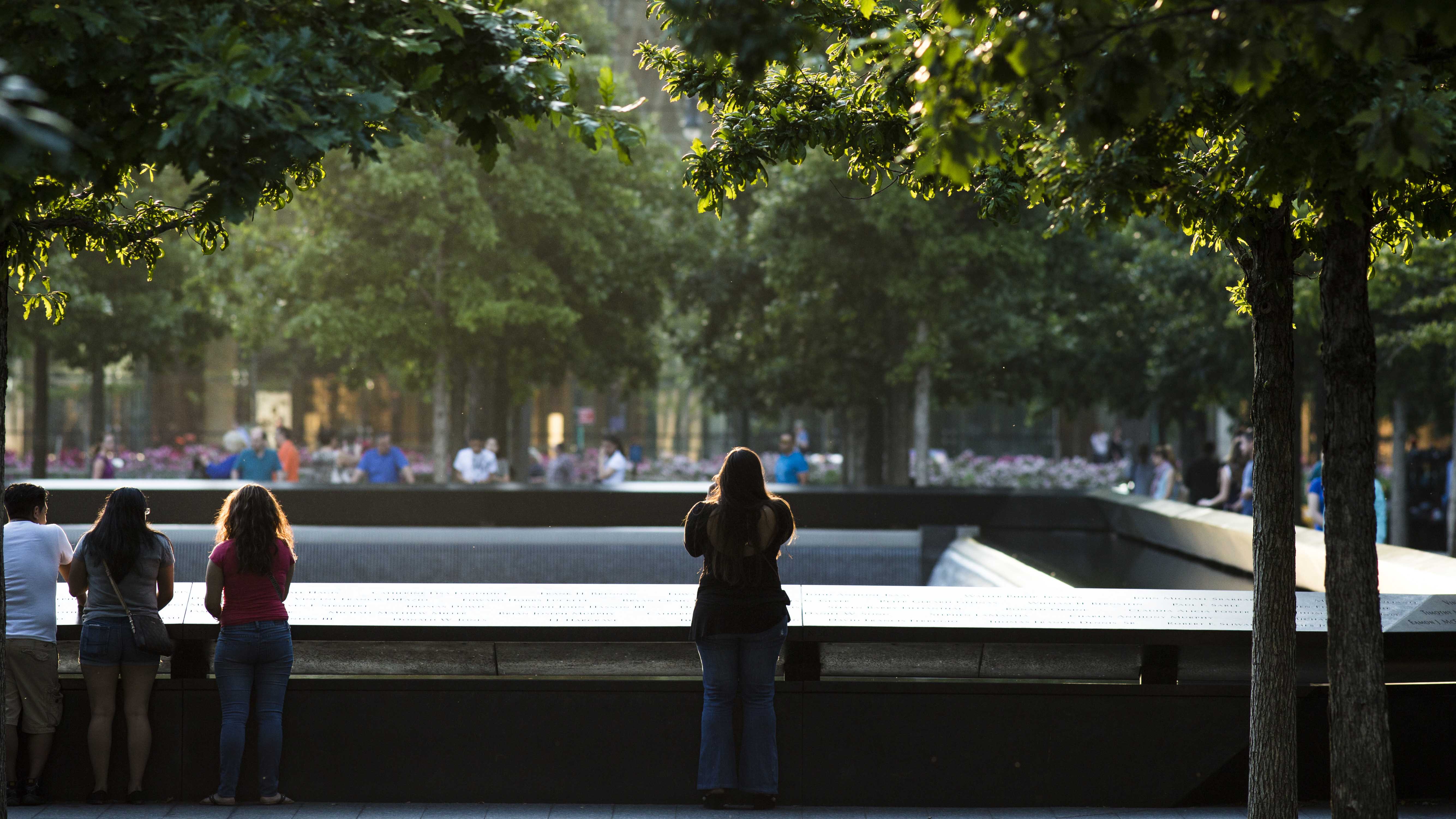
Purchase Tickets
The Museum is currently open to the public six days a week (closed Tuesdays) and requires advance ticket purchase . The Memorial is free and open to the public seven days a week; you may purchase our Outdoor Memorial Audio Guides during your visit.
About Your Visit
Follow these guidelines for a safe experience . Learn more about our events , how to get here , accessibility resources , visitor guidelines , and local partners offering visitor discounts .
The Museum is open Wednesday to Monday from 9 a.m. to 7 p.m. (last entry 5:30 p.m.).
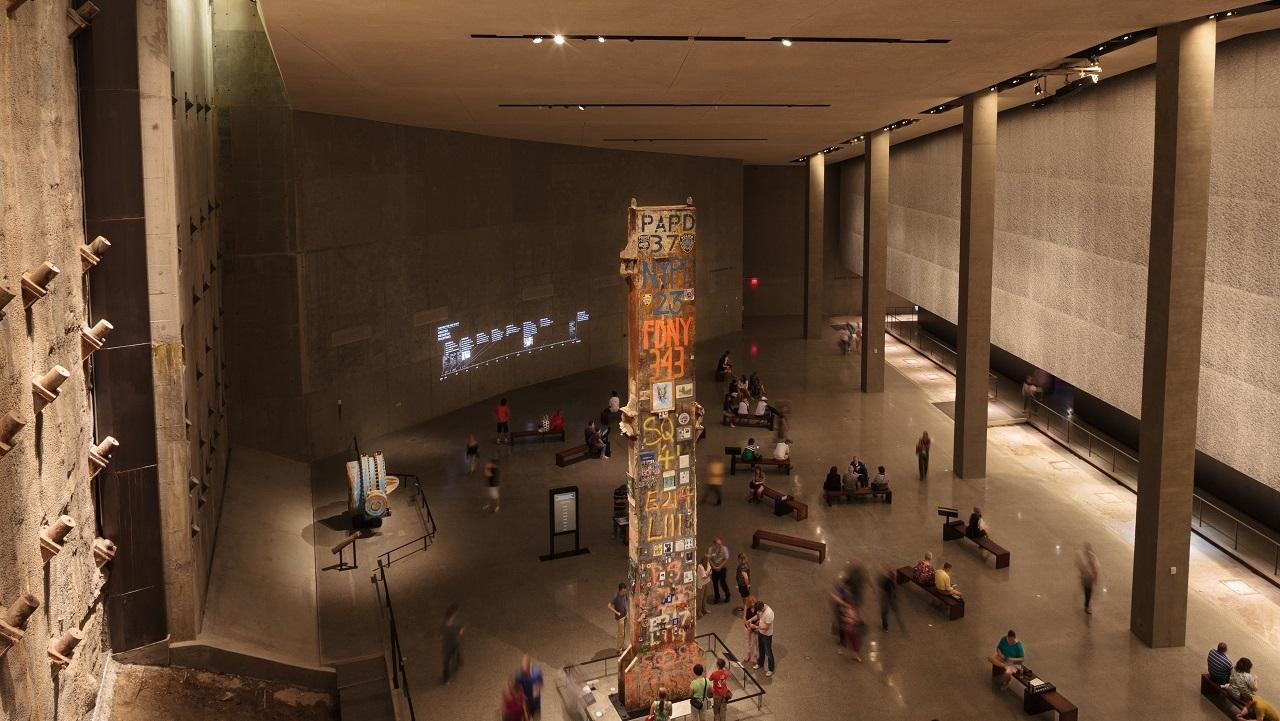
The 9/11 Memorial Museum serves as the country’s principal institution for examining the attacks of September 11, 2001 and documenting their continuing impact and significance.
The Memorial
The Memorial is open daily from 8 a.m. to 8 p.m.
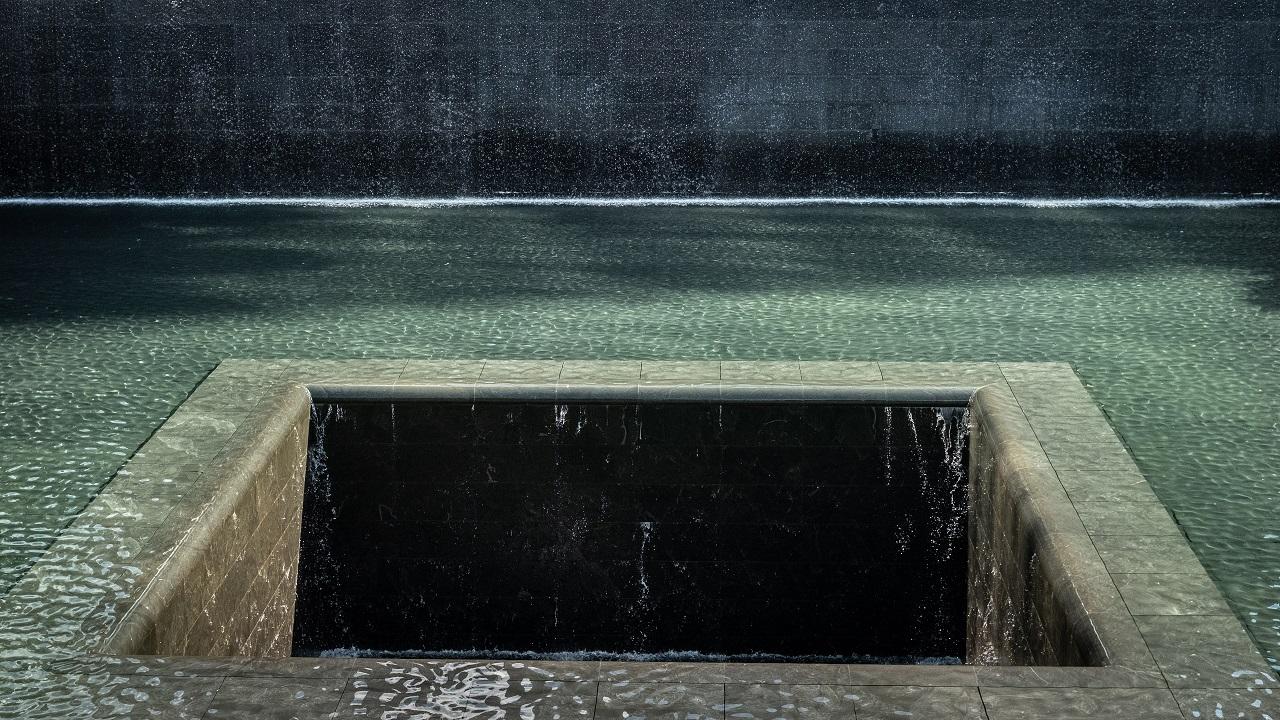
The 9/11 Memorial is a tribute of remembrance, honoring the 2,977 people killed in the terror attacks of September 11, 2001 at the World Trade Center site, near Shanksville, Pennsylvania, and at the Pentagon, as well as the six people killed in the World Trade Center bombing on February 26, 1993.
- Group Visits
- Museum Admission Discounts
- Health and Safety
- Visitor Guidelines
- Getting Here
- Accessibility
- Exhibitions
- The Collection
- Programs and Events
- Find a Name
- Outdoor Memorial Audio Guide
- 9/11 Memorial Glade
- The Survivor Tree
- Past Public Programs
- School Programs
- Lesson Plans
- Anniversary Digital Learning Experience
- Digital Learning Experience Archives
- Teacher Professional Development
- Activities at Home
- Youth and Family Tours
- Talking to Children about Terrorism
- Digital Exhibitions
- Interactive Timelines
- 9/11 Primer
- Oral Histories
- WTC Health Program
- Visiting Information
- Rescue and Recovery Workers
- Witnesses and Survivors
- Service Members and Veterans
- September 11, 2001
- Remember the Sky
- February 26, 1993
- May 30, 2002
- The MEMO Blog
- Sponsor a Cobblestone
- Other Ways to Give
- Member Login
- 5K Run/Walk
- Benefit Dinner
- Summit on Security
- Corporate Membership
- The Never Forget Fund
- Visionary Network
- Give to the Collection

IMAGES
VIDEO
COMMENTS
How 9/11 changed travel forever. The attacks may have sparked a new era of tightened security for tourists and left New York City swept clean of its beloved visitors - but the city's resilience ...
v. t. e. The September 11 attacks, commonly known as 9/11, [e] were four coordinated Islamist suicide terrorist attacks carried out by Al-Qaeda against the United States on September 11, 2001. That morning, 19 terrorists hijacked four commercial airliners scheduled to travel from the East Coast to California.
The "tourist guy" was an internet phenomenon that featured a photograph of a tourist on the observation deck of the World Trade Center digitally altered to show a plane about to hit the tower in the background during the September 11 attacks. The photo went viral in the days after the attacks as many manipulated pictures spread online. The man ...
On September 11, 2001 —a clear, sunny, late summer day—al Qaeda terrorists aboard three hijacked passenger planes carried out coordinated suicide attacks against the World Trade Center in New ...
The 9/11 terrorist attacks immediately exposed the vulnerabilities in US aviation security. The tough new measures introduced by the end of 2001 would fundamentally change the flying experience in ...
The September 11 attacks of 2001 were the deadliest terrorist attacks in human history, causing the deaths of 2,996 people, including 2,977 victims and 19 hijackers who committed murder-suicide.Thousands more were injured, and long-term health effects have arisen as a consequence of the attacks. New York City took the brunt of the death toll when the Twin Towers of the World Trade Center ...
Three ways terrorist attacks of September 11, 2001 changed our world. The multi-pronged attacks took place in broad daylight on a Tuesday morning. Even as the events of September 11, 2001, were ...
Asked to reflect on the 20th anniversary of the attacks, they pointed to four broad, specific examples of how 9/11 continues to shape America and the world, plus a fifth that may — or may not — come to pass. ... And as president, he largely suspended tourism, business and academic visits from Muslim countries. "Islamic terrorism, quote ...
Industry shock. Commercial flights were halted for several days. Airline executives pondered the industry's future. "We immediately grounded all our airplanes," said David Neeleman, founder ...
How 9/11 changed air travel: more security, less privacy. Travelers wear face coverings in the line for the south north security checkpoint in the main terminal of Denver International Airport Tuesday, Aug. 24, 2021, in Denver. Two months after the Sept. 11, 2001 attacks, President George W. Bush signed legislation creating the Transportation ...
Here's a timeline of how the events unfolded that day: 8:46 am ET - American Airlines Flight 11 (traveling from Boston to Los Angeles) strikes the North Tower of the World Trade Center in New York ...
The World Trade Center on September 11th. In July 2001, just two months before the terrorist attacks of September 11, the Port Authority agreed to lease the twin towers to Larry Silverstein, a New ...
On September 11, 2001, the first hijacked plane, American Airlines Flight 11, slammed into the North Tower of the World Trade Center in Lower Manhattan at 8:46 a.m. The second plane, United ...
Getty Images. By Patrick Jackson. BBC News. On Tuesday 11 September 2001 suicide attackers seized US passenger jets and crashed them into two New York skyscrapers, killing thousands of people. The ...
On 9/11, Ken Diaz, a flight attendant and AFA-CWA president at United Airlines, had been in the Newark Airport ready room alongside flight attendants from Flight 93, which later crashed in ...
On September 11, 2001, 2,977 people were killed in the deadliest terrorist attacks in American history. The World Trade Center in March, 2001 Wikimedia Commons. The moment shocked the nation. Two planes, hijacked by Islamic jihadists vowing death to all Americans, plowed into both towers at the World Trade Center in New York.
The following year, the UNWTO noted "2002 was certainly not easy" but reported: "International tourist arrivals grew 2.7% . . . although uncertainty continued to play a major role under the threat of new terrorist attacks and the looming Iraq conflict.
The impact of 9/11 on travel and tourism flows to the United States has been evaluated in several studies. Lee et al. (2005), for example, evaluate the initial impact of the 9/11 attacks on the demand for air travel to the United States using a time series intervention model and find a significant overall drop in demand.
As early as September 2002, just a year after the attacks, the Congressional Research Service, in a report to Congress, concluded that in terms of the broad national economy, "9/11 is more ...
transcript. America Observes the 20th Anniversary of 9/11 Ceremonies were held in remembrance at the sites where nearly 3,000 people were killed in terrorist attacks on Sept. 11, 2001.
How did the attacks on 9/11 affect tourism? The number of international visitors declined from about 6.8 million in 2000 to about 5.7 million in 2001, with most of that loss coming after Sept. 11 ...
The 9/11 Memorial Museum serves as the country's principal institution for examining the attacks of September 11, 2001 and documenting their continuing impact and significance. ... Information about the 9 11 Memorial & Museum. Location. 180 Greenwich Street New York, NY 10007 View on map. [email protected] (212) 312-8800; Contact ...